Model Village
(2020-)Soft buildings, sewn
with recycled materials,
various sizes


The term Model Village refers to communities once built by wealthy landowners to house their workers, as well as the miniature model village tourist attractions I visited as a child. It may once have evoked an idealised community, but over time these associations have become clouded and contradictory. The inexorable rise in housing inequality, insecurity and homelessness raise questions about what it even means to be part of a physical community now.
Model village extract from Land Ground Earth Soil (2019).
My interest in this springs from previous research for Land Ground Earth Soil, which includes a theory in evolutionary psychology that 150 is found to be the optimal number of people who can live in a community together, based on trust and moral obligation. Historic records reveal that 150 was not only the average village size in the 18th century, but also in the Domesday Book of 1086. Interestingly this is also found to apply to social media, irrespective of how many ‘friends’ or ‘followers’ a person appears to have.
Unlike digital communities, which pervade so much of our collective consciousness; physical communities, as in the geographic places where people dwell, can seem arbitrary and undynamic by comparison. I use the word ‘dwell’ here advisedly to mean where a person lives, works, resides or exists.
Unlike digital communities, which pervade so much of our collective consciousness; physical communities, as in the geographic places where people dwell, can seem arbitrary and undynamic by comparison. I use the word ‘dwell’ here advisedly to mean where a person lives, works, resides or exists.
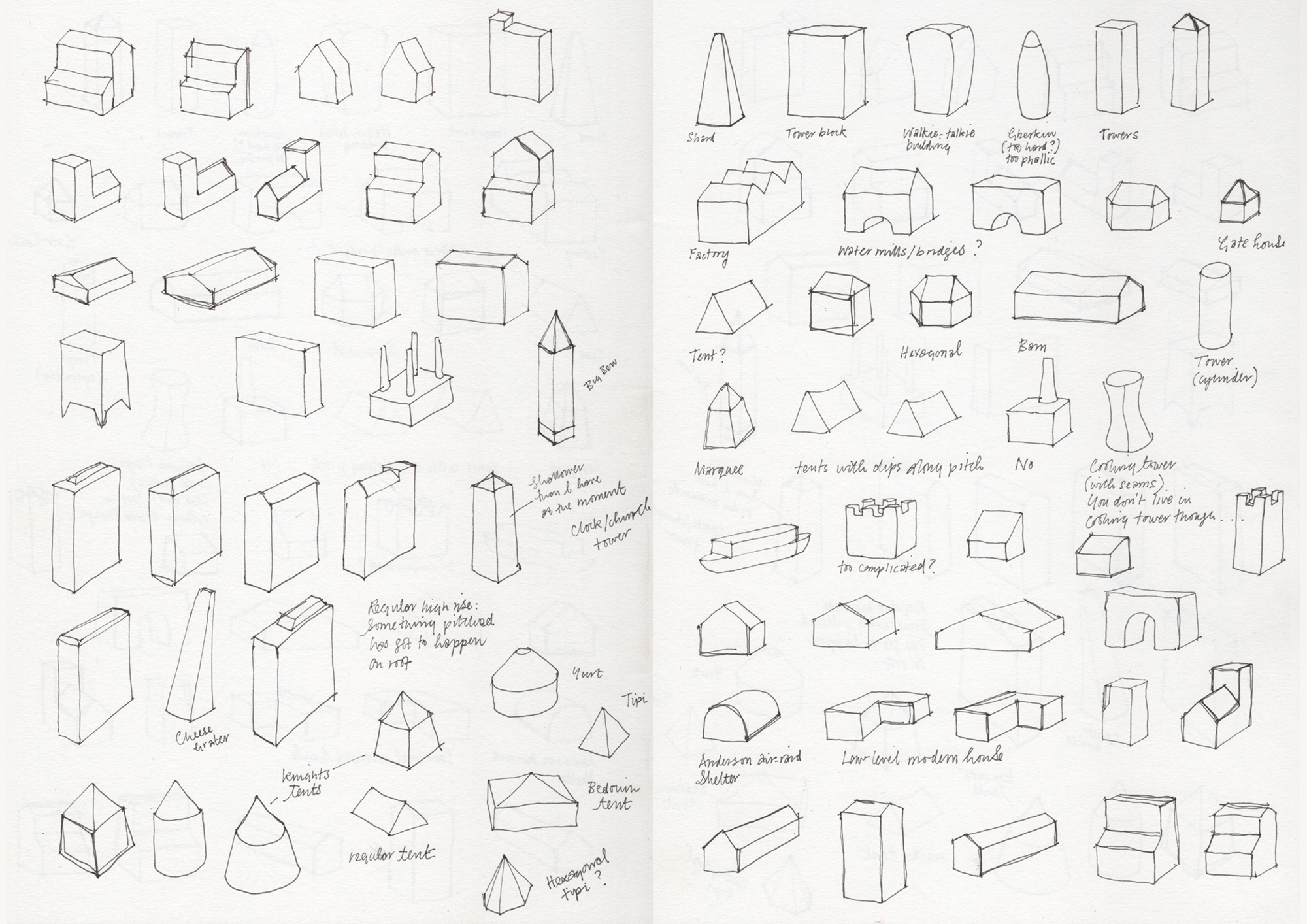
Sketchbook pages.
The project uses abstracted forms of buildings and structures, stripping away as much detail as possible while retaining recognisable proportions. This process of creating building shapes that are abstract yet familiar also explores the prevalance of the pitched roof as an important symbol of shelter, and includes temporary static structures like tents, whose uses range from emergency housing to festivals and glamping.
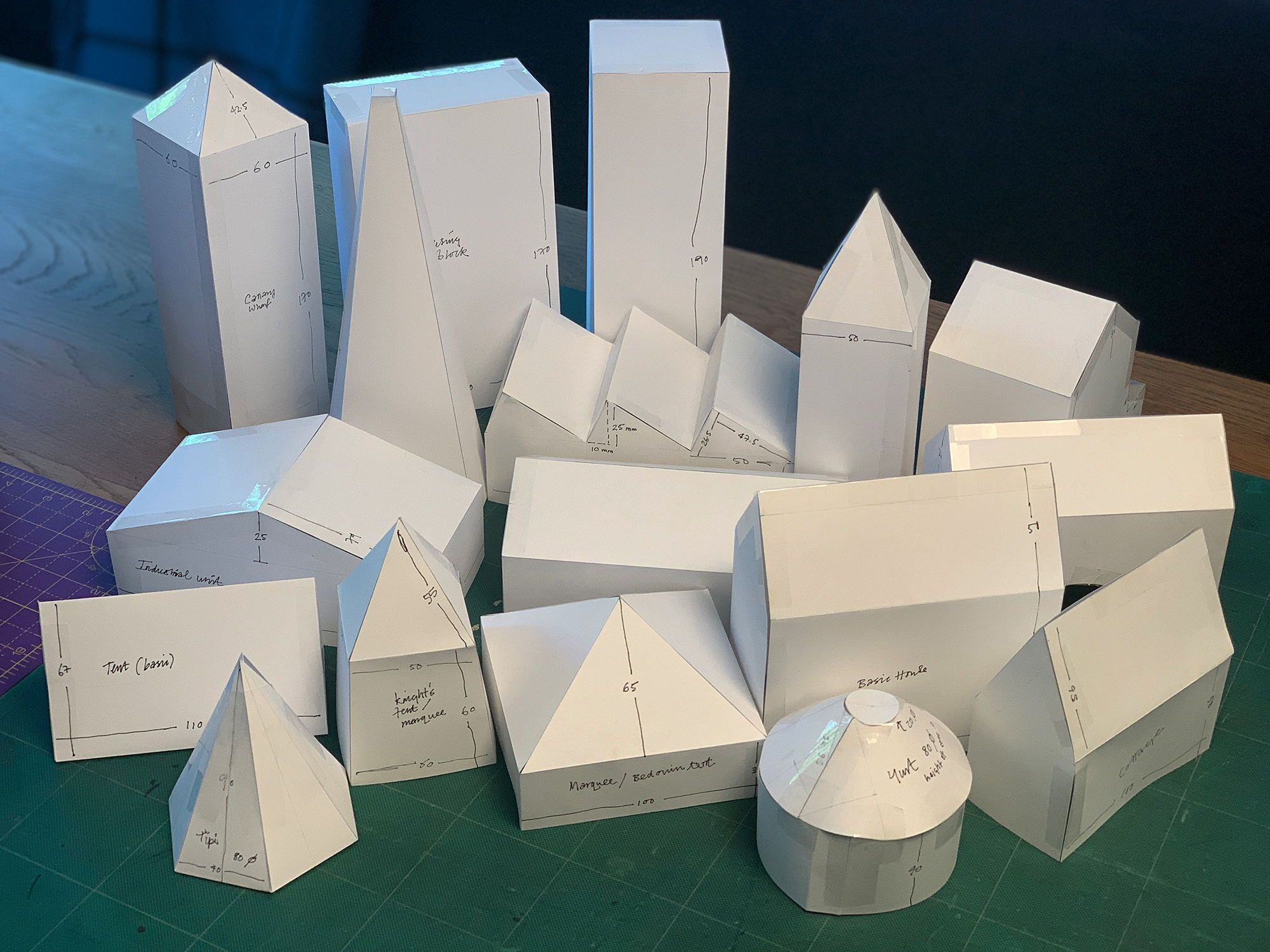
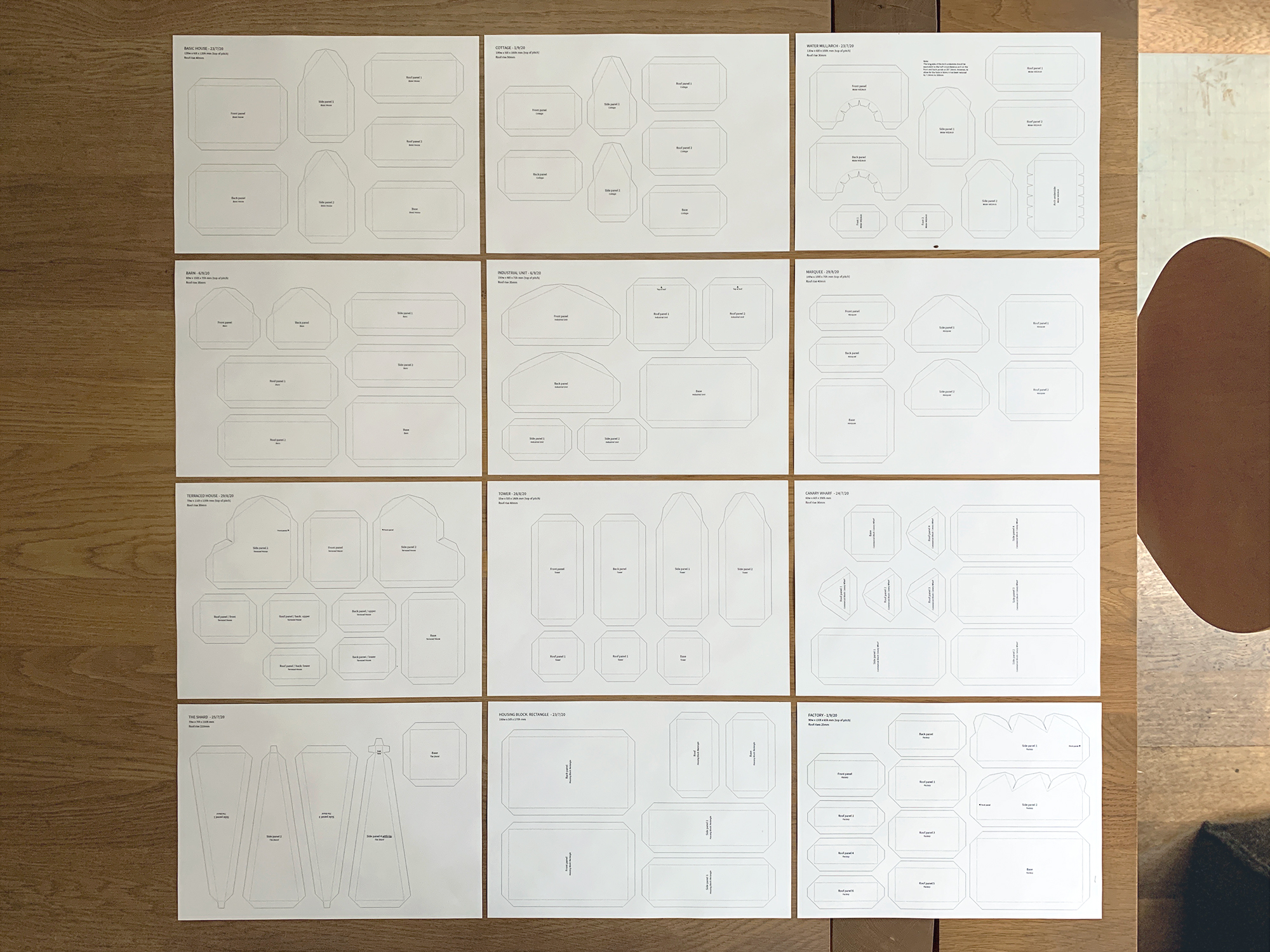
The models represent types or categories of buildings and structures (with the occasional specific exception). They are out of scale with their counterparts in the real world yet retain their recognisable proportions. The absence of scale strips away the power that comes with size from the larger buildings. It allows them to viewed objectively as mere shapes, as objects that can now relate directly with each other - in this new model village.

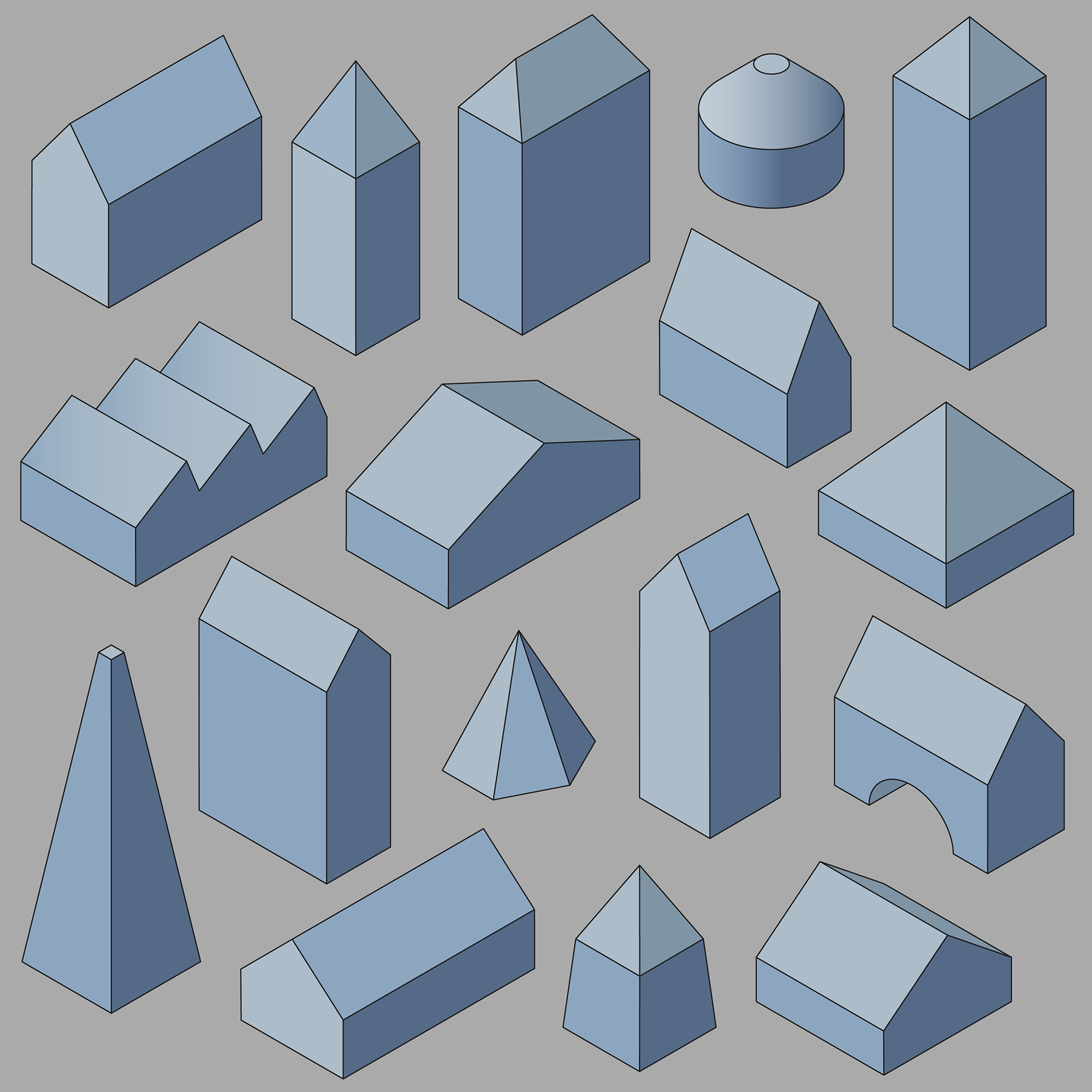



Themes of impermanence in temporary structures like tents informed my approach of making soft buildings, with materials that address related issues of unsustainable consumerism such as fast fashion and textile waste.

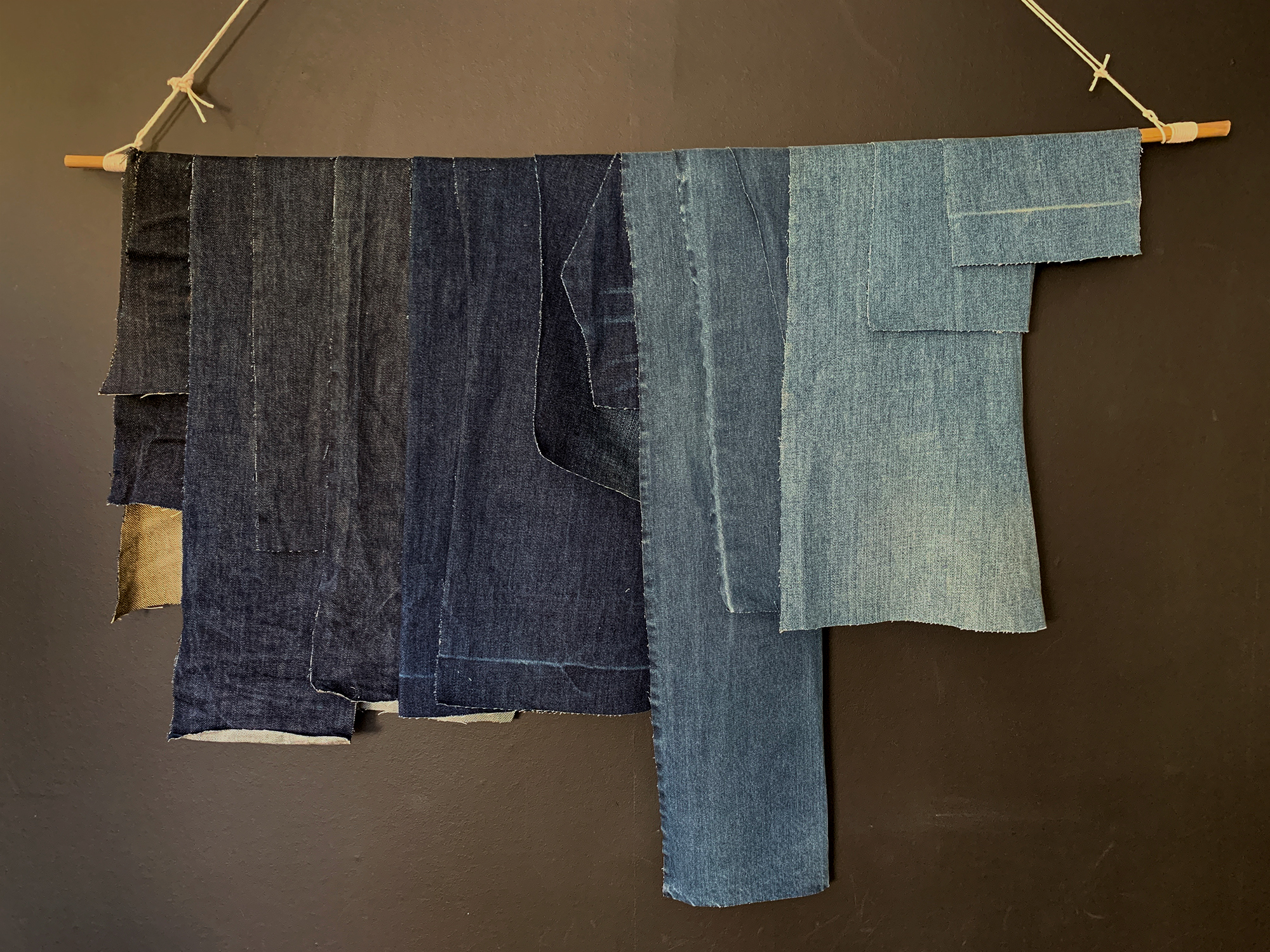

The buildings are made with reused denim taken from clothing bought at homelessness charities such as Shelter and Crisis, and filled with recycled knitting wool from a Scottish social enterprise.




I remove the fronts and backs of the denim jean legs, leaving behind the waistband, pockets and seams. Collected together, the remaining short shorts take on a comedic uniformity. I keep all the offcuts, and this process of cutting and removing brings to mind the graphic posters I see of butchers’ meat cuts, so I make my own version.
 Denim jean ‘cuts’.
Denim jean ‘cuts’. The denim bears the marks and scars of previous lives, and is patched together to reduce waste. The buildings look like soft furnishings, reminiscent of fancy homeware shop cushions that speak to our desire for cosiness and wellbeing, for hygge - perhaps as comfort in these divided and insecure times. They purposefully embrace the project’s ambiguity between art and product, reflecting my own practice as artist and designer.




These are some of the work in progress pictures. They will be regularly updated as the model village grows. You can also view project updates in Process and by following _model_village_.
1 Family photo and still from Land Ground Earth Soil (2019).
Land Ground Earth Soil
(2019)Film, 17 mins, 4:3
Book, A6, 80pp
Exhibition/screenings
My final MA project looked at British land ownership and our disappearing democratic spaces - against the backdrop of Brexit, rising inequality and climate change.
The project sprang from my interest in the UK’s broken housing market and how its effects reach further into our everyday lives than we realise. Land ownership is notoriously secretive, and largely kept out of the public eye. Even the different language we use to talk about the ground beneath our feet has helped to perpetuate this.
For example, we use the word ‘earth’ when talking about climate change, ‘ground’ for roadworks and ‘soil’ for agriculture. While ‘land’ is used when talking about ownership, whether perceived or real. The gaps that open up between the use of these words effectively silo pressing issues that should be seen as part of a whole, like homelessness, tax-avoidance and climate change.
The project uses montage and juxtaposition to challenge this dissonance and to draw out overlooked connections and contradictions. It urges the viewer to remember that we are all stakeholders in our land, ground, earth, soil - whichever word we use. It is a common good, and public dialogue about its ownership is long overdue.
The project sprang from my interest in the UK’s broken housing market and how its effects reach further into our everyday lives than we realise. Land ownership is notoriously secretive, and largely kept out of the public eye. Even the different language we use to talk about the ground beneath our feet has helped to perpetuate this.
For example, we use the word ‘earth’ when talking about climate change, ‘ground’ for roadworks and ‘soil’ for agriculture. While ‘land’ is used when talking about ownership, whether perceived or real. The gaps that open up between the use of these words effectively silo pressing issues that should be seen as part of a whole, like homelessness, tax-avoidance and climate change.
The project uses montage and juxtaposition to challenge this dissonance and to draw out overlooked connections and contradictions. It urges the viewer to remember that we are all stakeholders in our land, ground, earth, soil - whichever word we use. It is a common good, and public dialogue about its ownership is long overdue.
 Stills from the Land Ground Earth Soil film.
Stills from the Land Ground Earth Soil film. The focus of the project is the film essay Land Ground Earth Soil. It combines my narrated prose with footage that includes protests, timelapses, thought-experiments, sign interventions and interviews1.
These elements are woven together with clips from movies, tv, news, city-building video gameplay and 20th century public information films.
These elements are woven together with clips from movies, tv, news, city-building video gameplay and 20th century public information films.


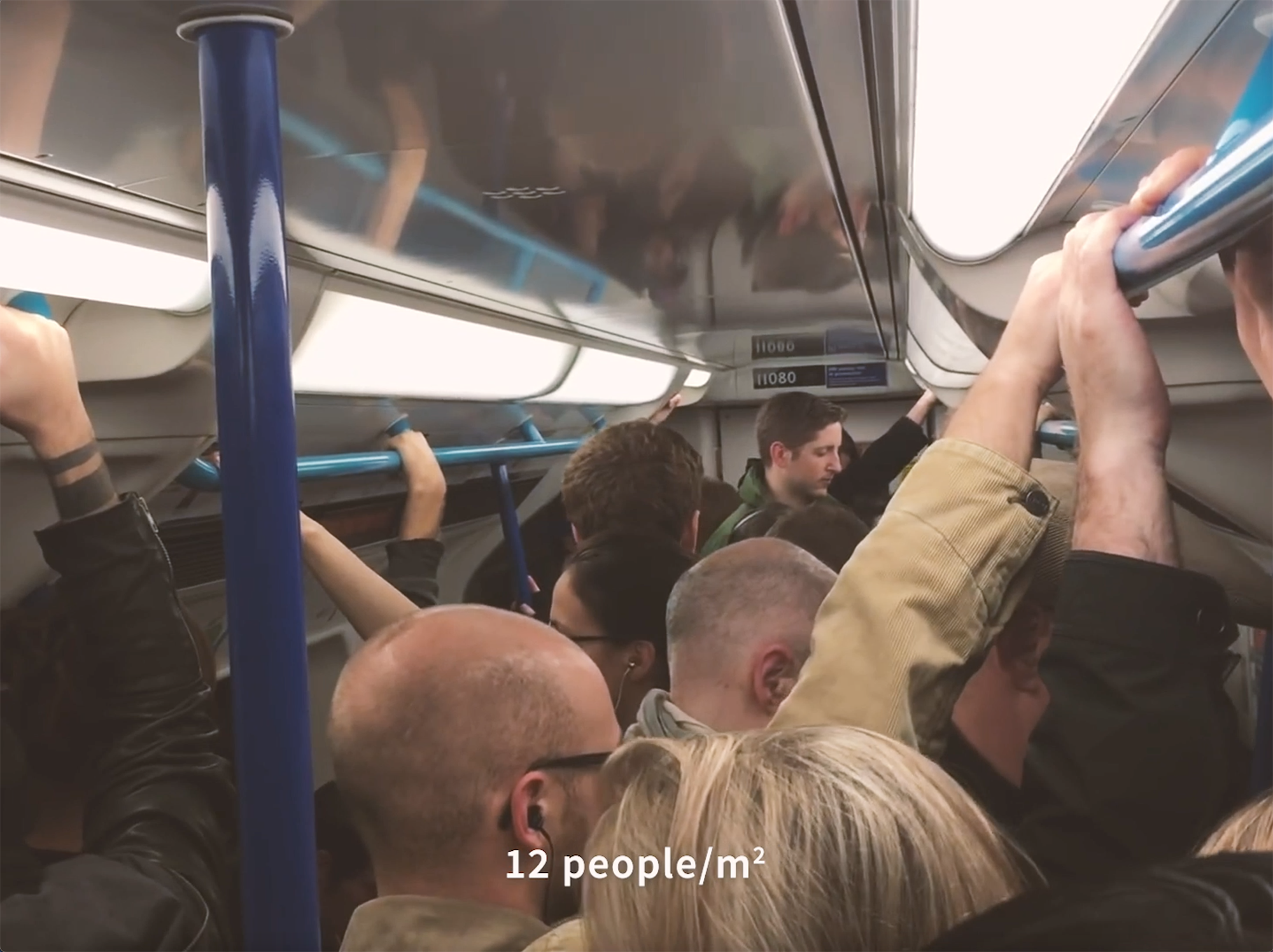
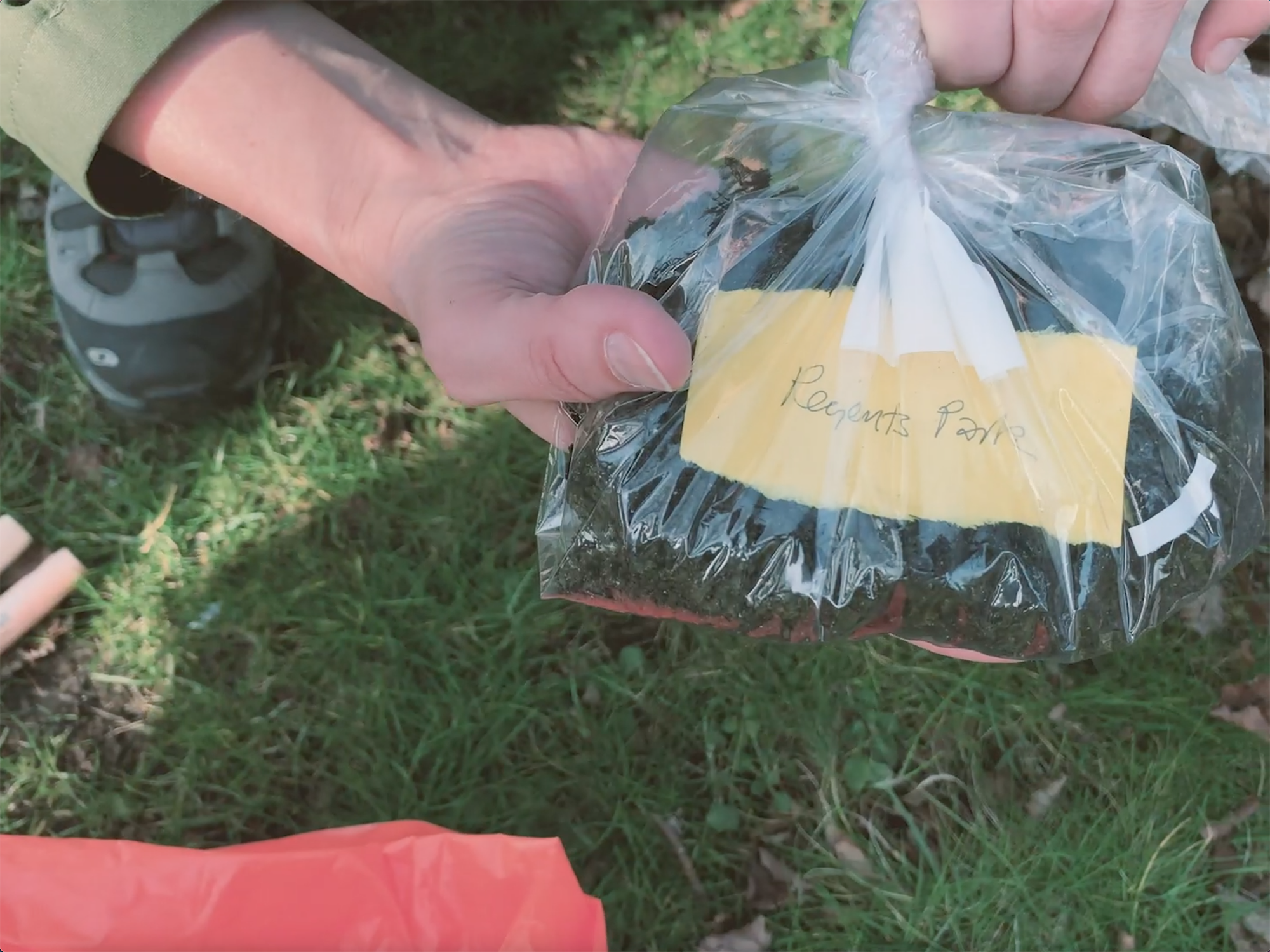
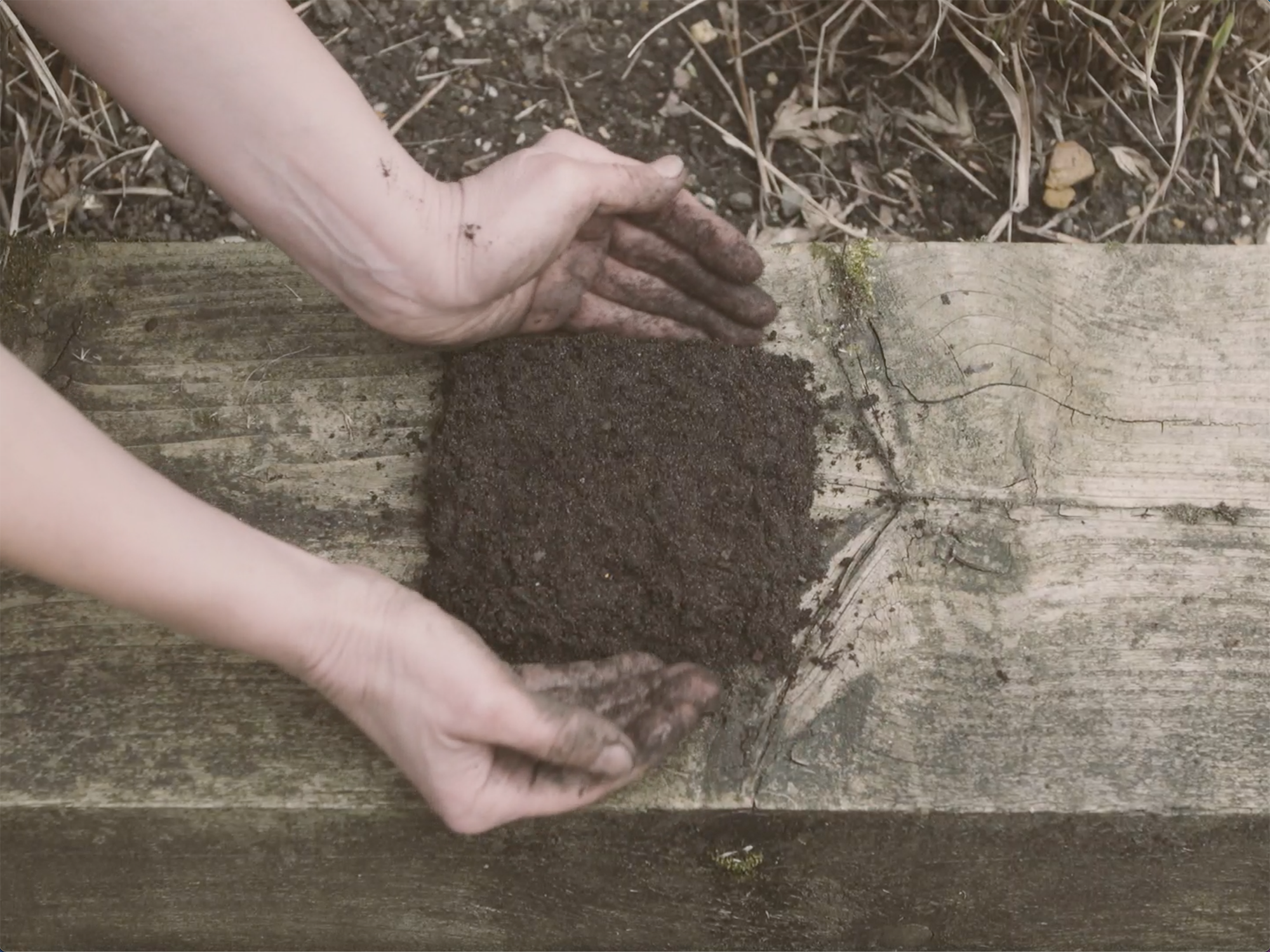




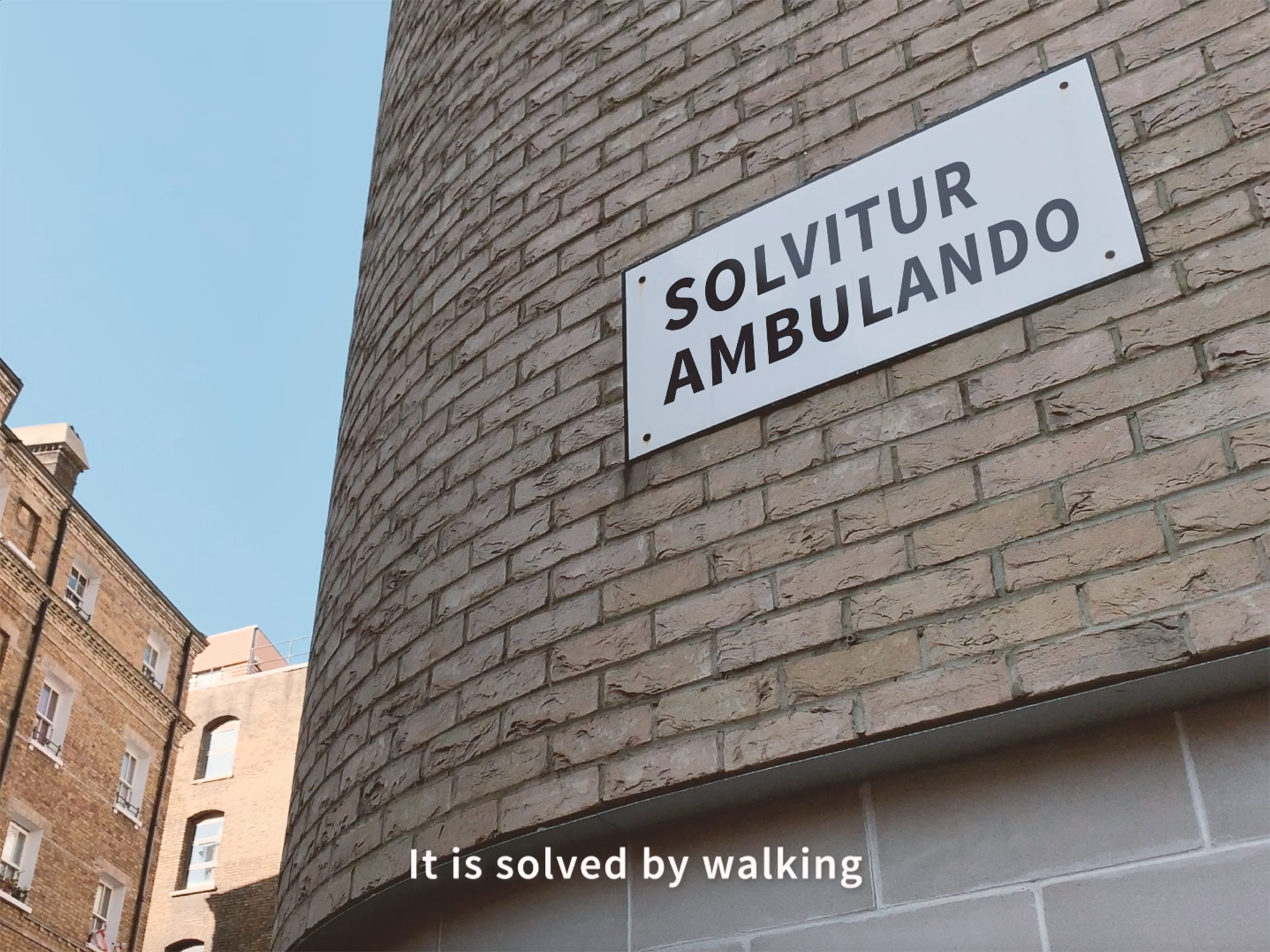
The film can be viewed here︎︎︎
The book of the same name accompanies the film. It is intentionally pocket-sized, like a travel guide, and provides a transcript of the narration and subtitles. They run alongside my written text, which is drawn from wider research and analysis; as well as notes and references.



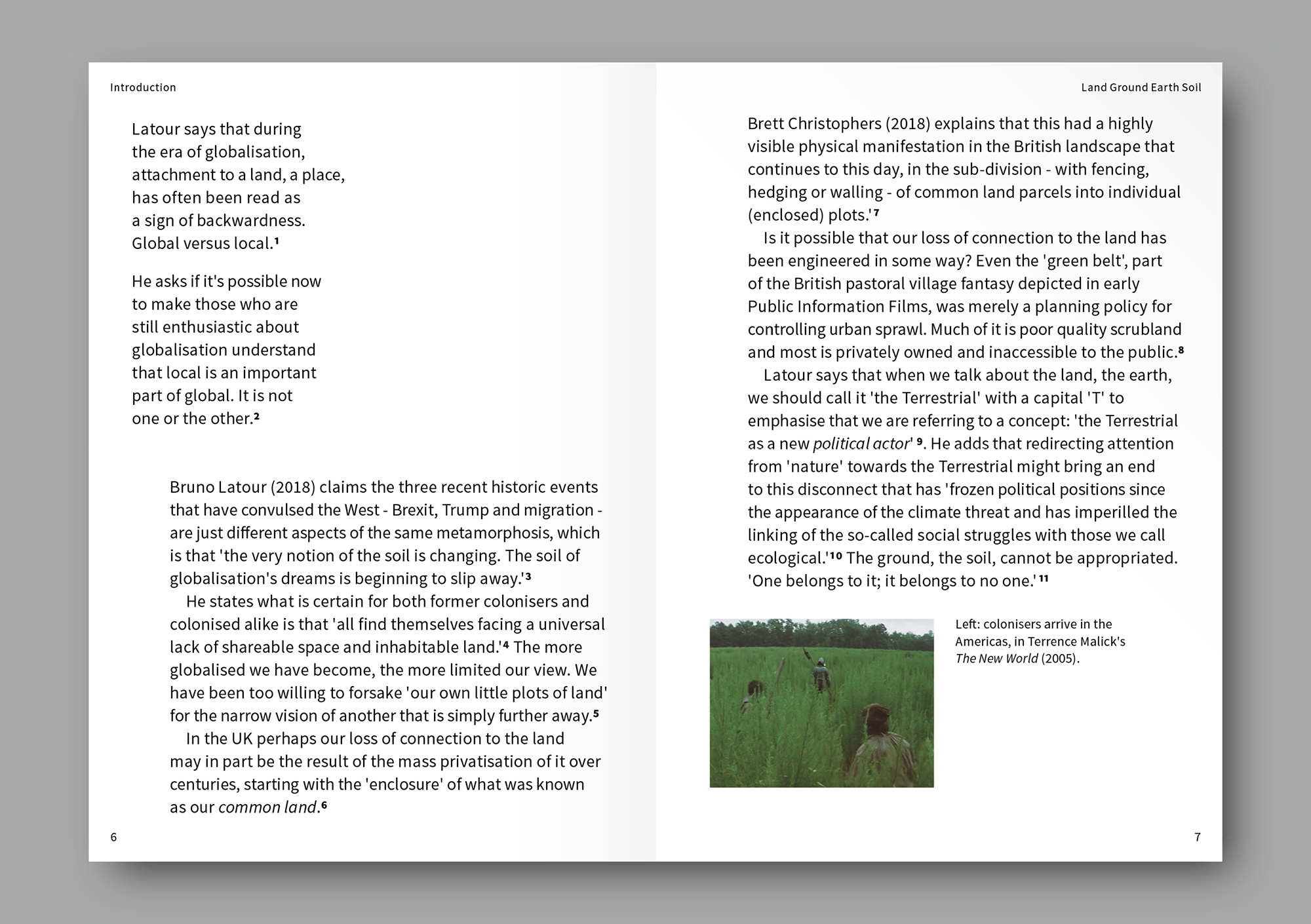



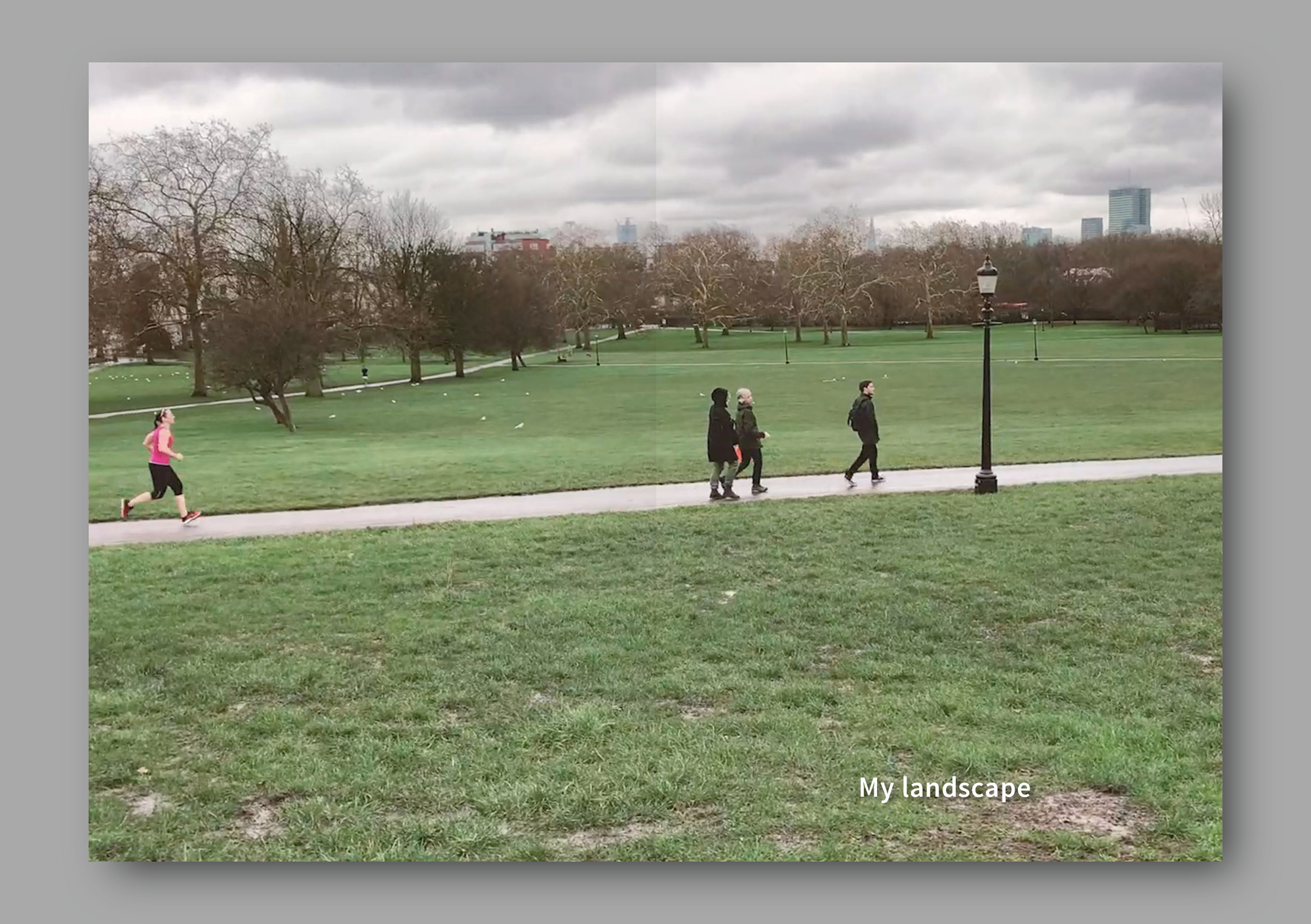



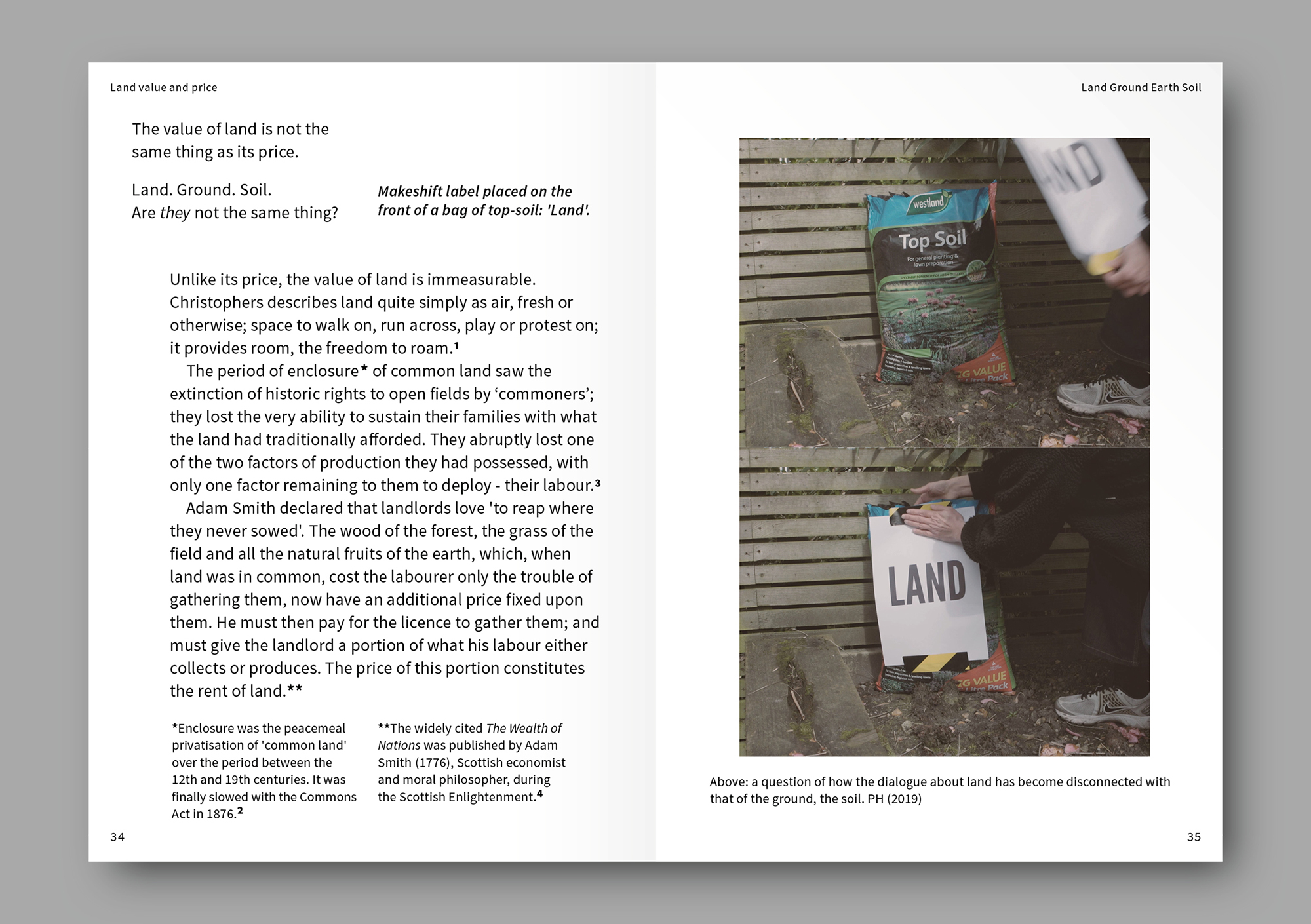
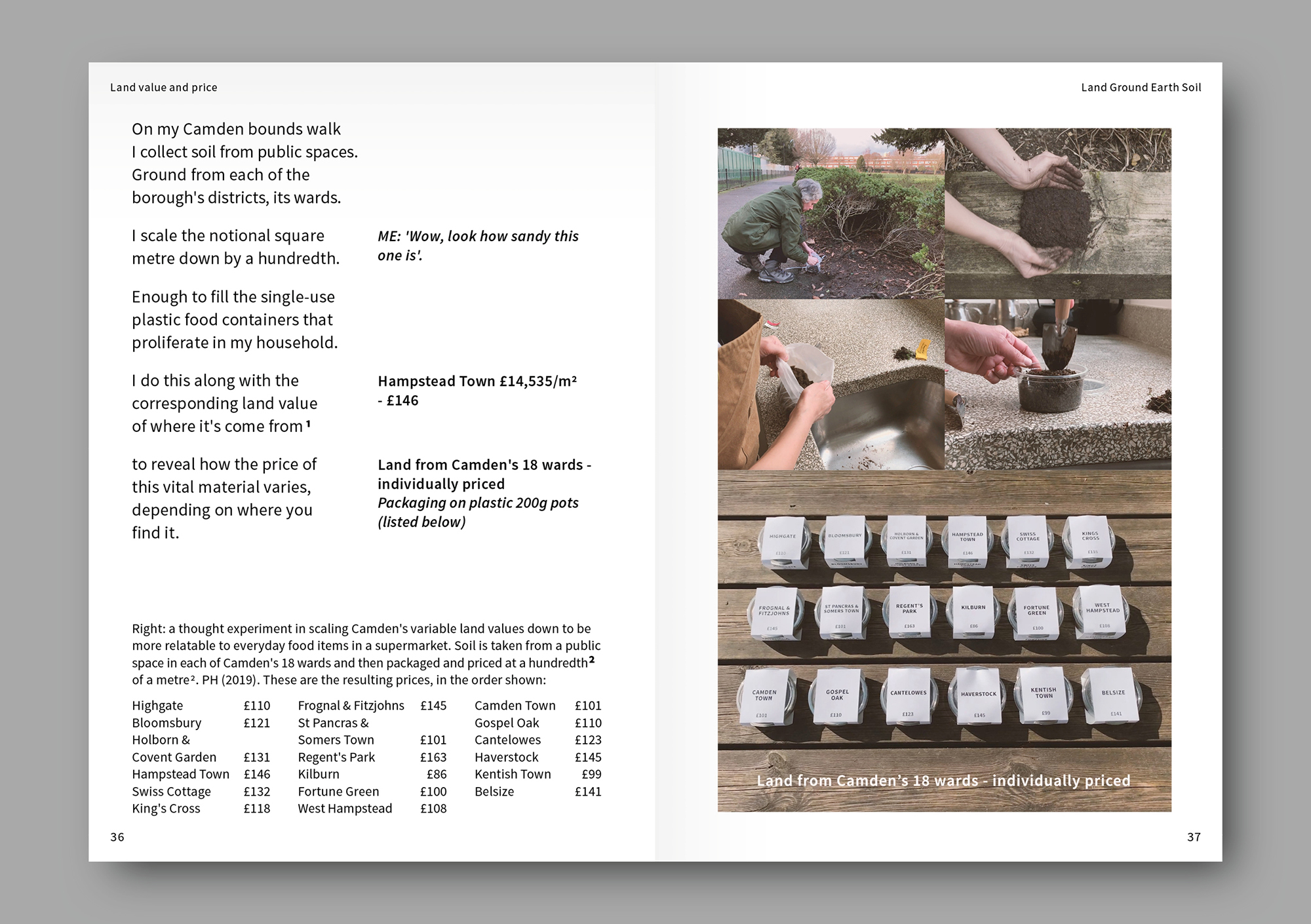



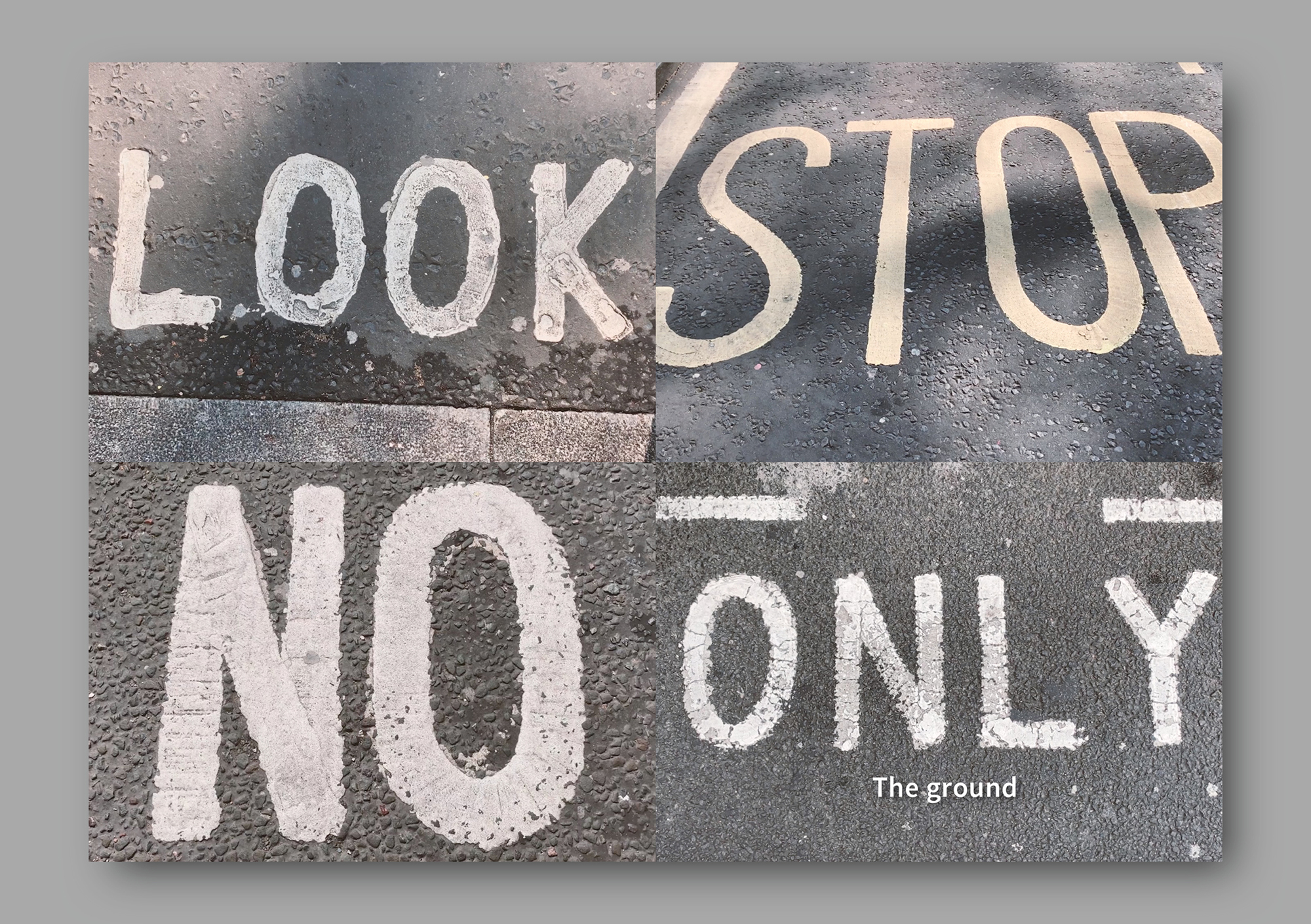

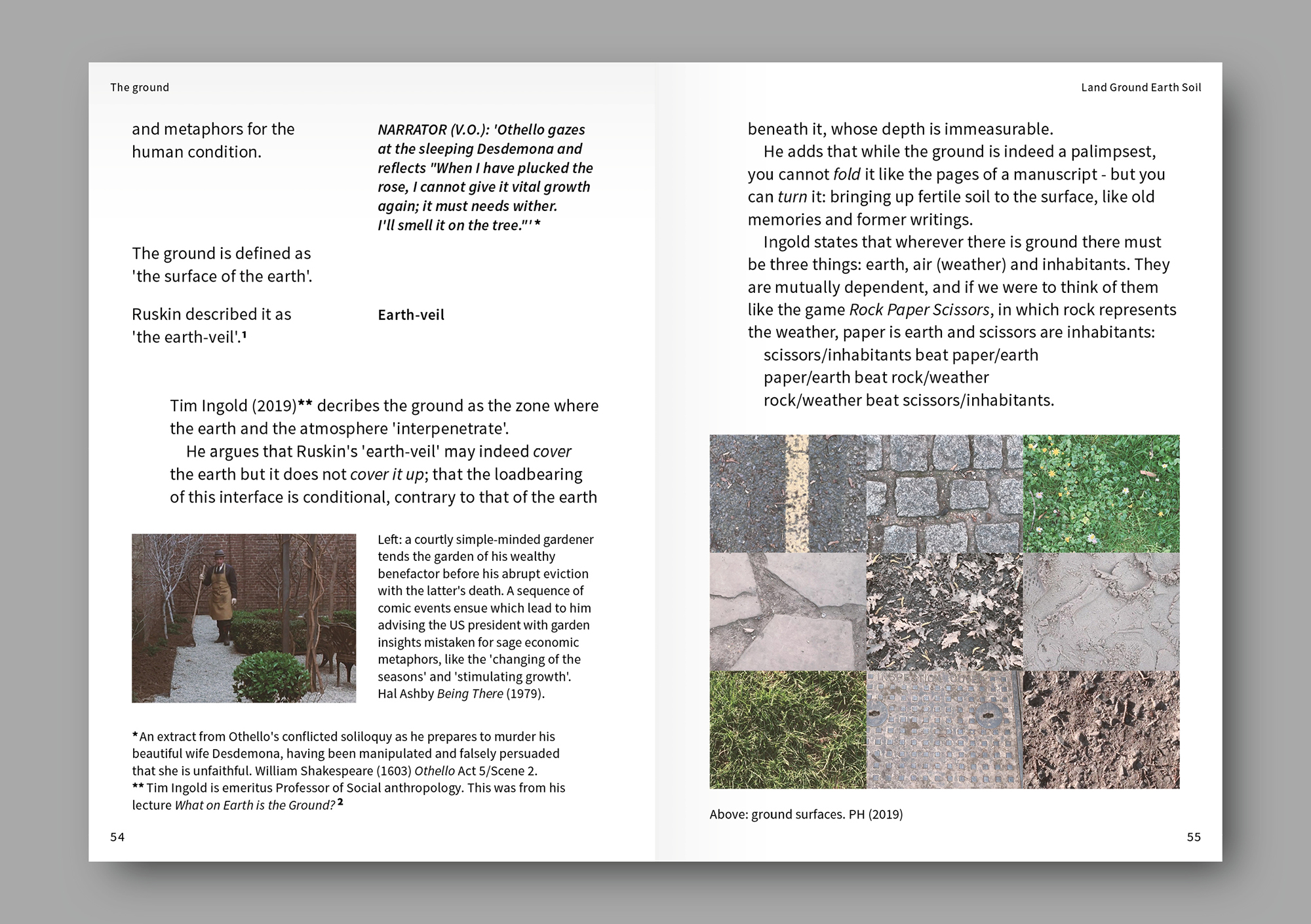

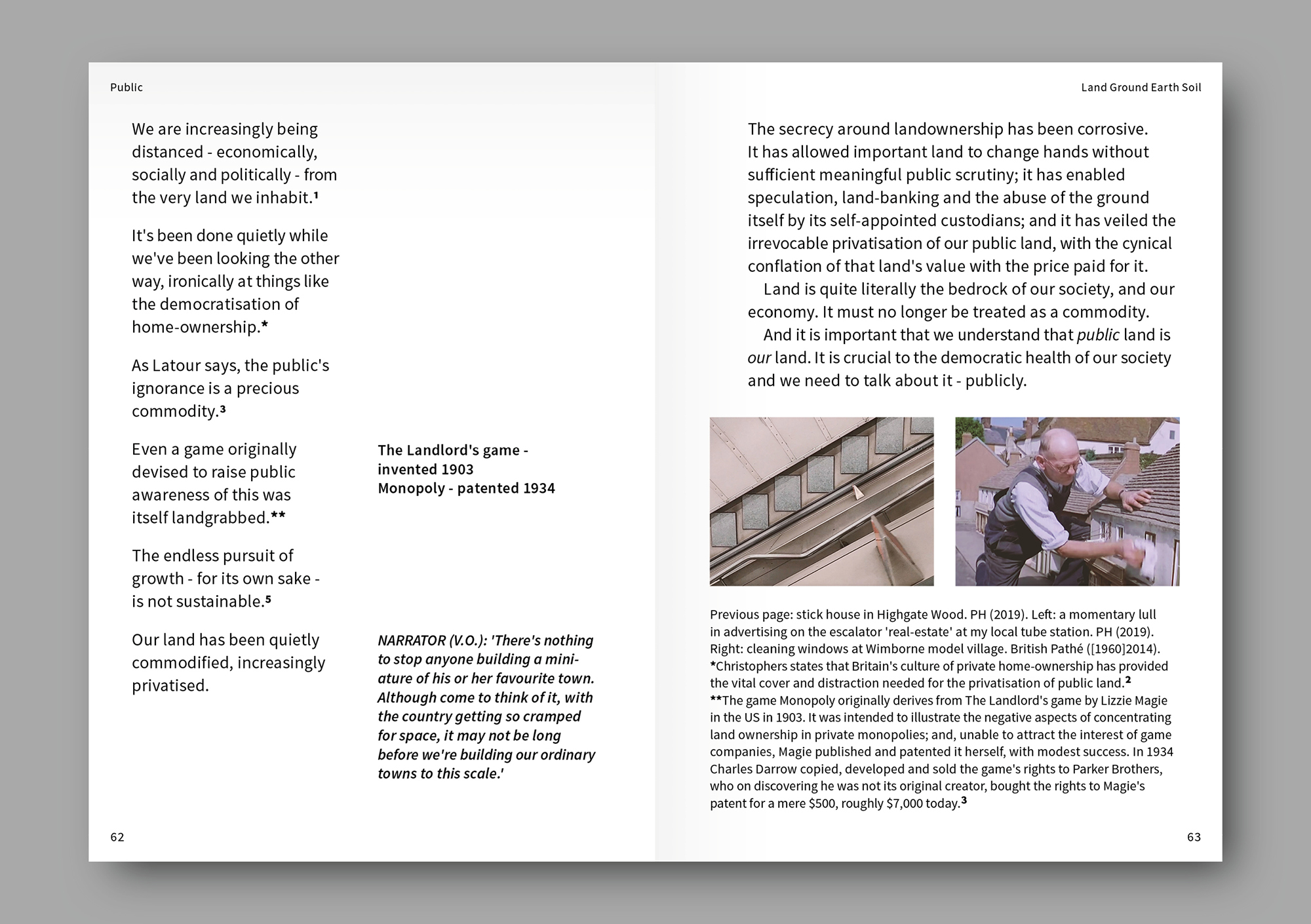
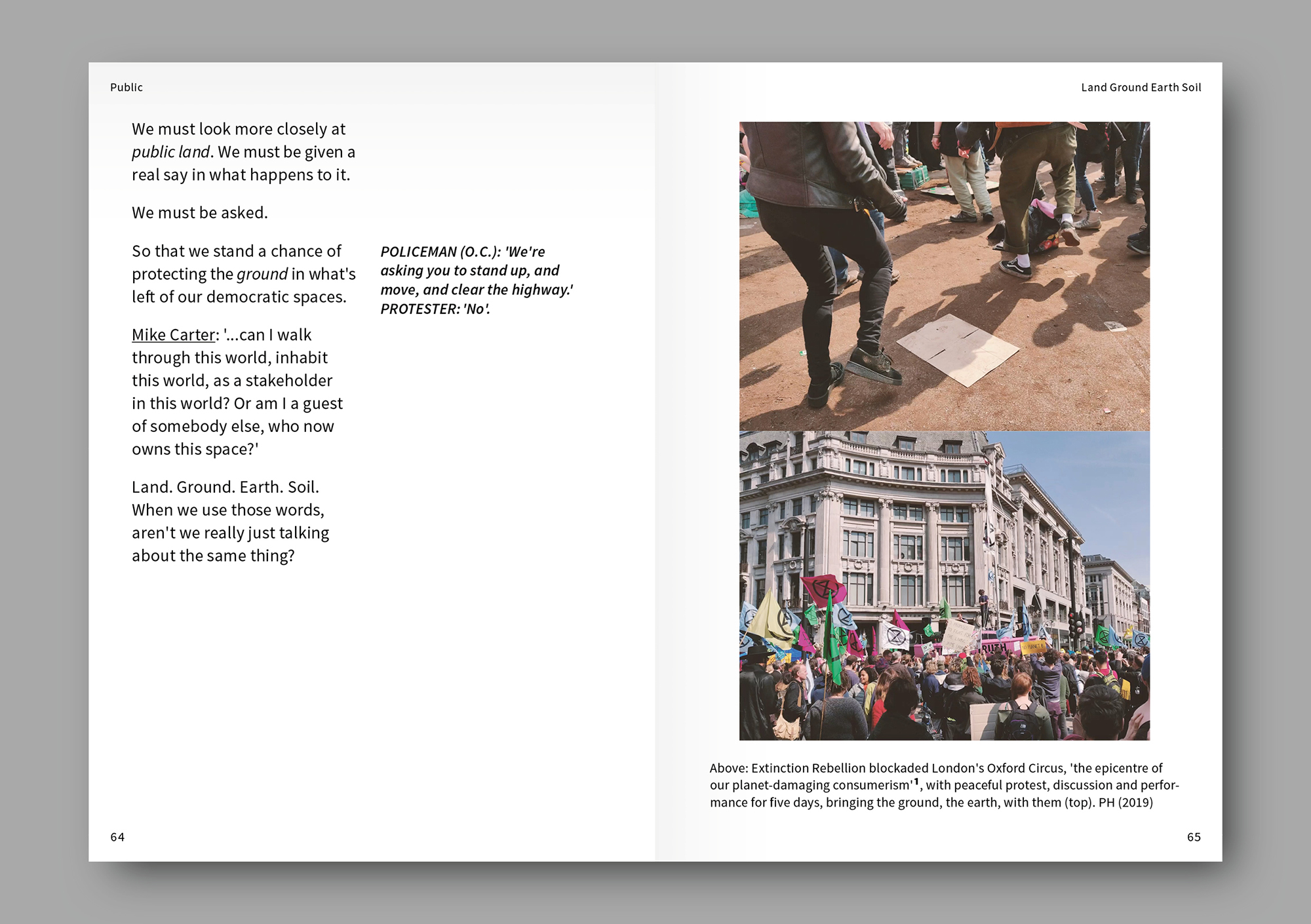

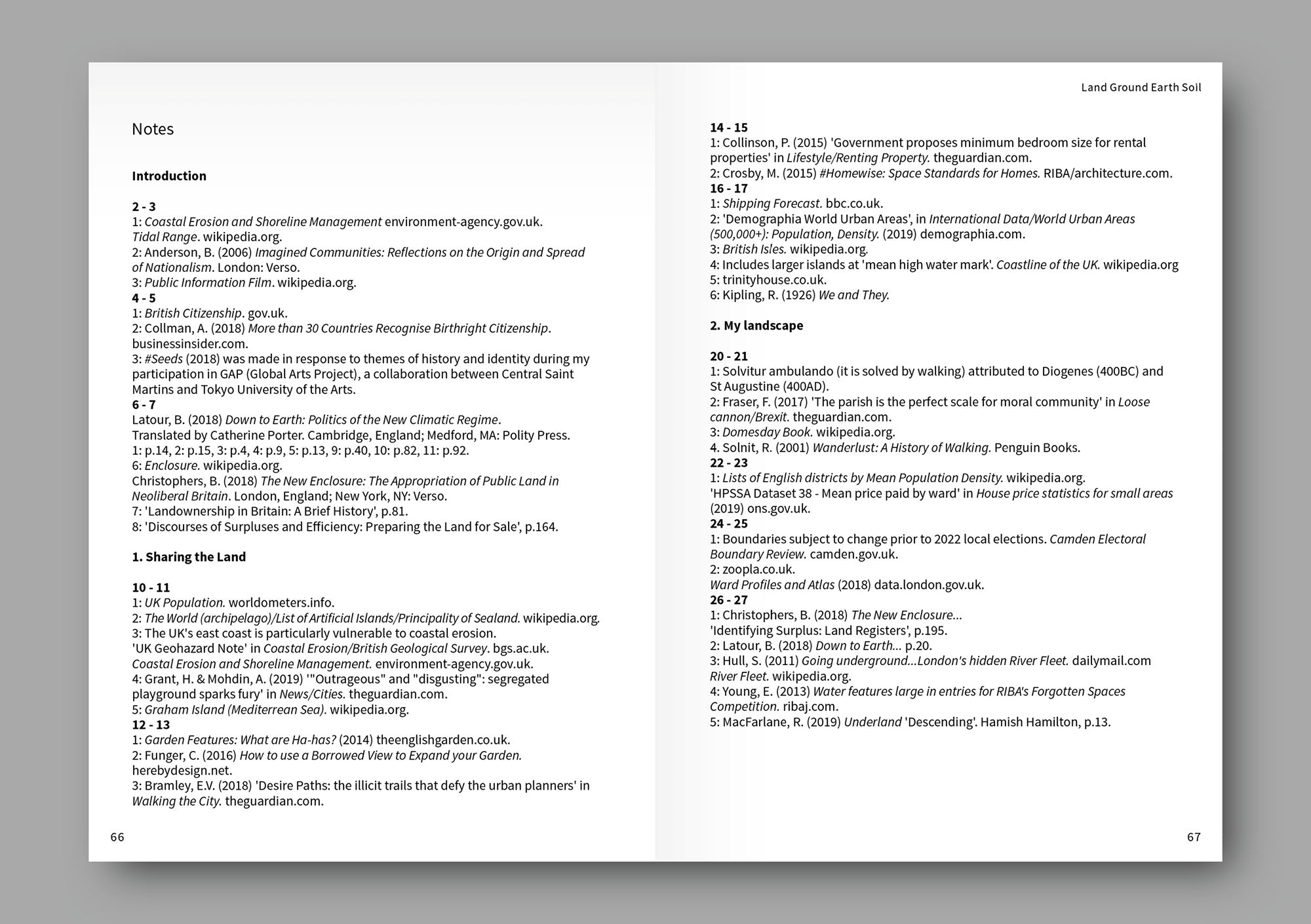

If you would like to purchase a printed and bound copy of the book for £10+pp please email me via the link on the info page.

The film screened for the MA show in its own mini-cinema - a garden shed3. It was adapted for gallery use, with a monitor, speakers, seating for four, and copies of the book for browsing.
The project gained an MA Distinction, nomination for the MullenLowe NOVA Awards and commendation by the Maison 0/Green Trail (CSM/LMVH) 2019. The film went on to be screened in further group shows:
The project gained an MA Distinction, nomination for the MullenLowe NOVA Awards and commendation by the Maison 0/Green Trail (CSM/LMVH) 2019. The film went on to be screened in further group shows:
- Designing in Turbulent Times at the Lethaby Gallery, London.
-
The Next Thing Moving Image Award at Bury Art Museum, Bury.
- Depictions of Living at The Art Pavilion, London.
1 Grateful thanks for the kind participation of Central St Martins staff and students.
2 Filmed interviewees include: Mike Carter, Guardian journalist and author of All Together Now? One Man’s Walk in Search of his Father and a Lost England (2019) Guardian Faber; Brett Christophers, Professor of Human Geography and author of The New Enclosure: The Appropriation of Public Land in Neoliberal Britain (2019) Verso; Scot, homeless, King’s Cross; Ben Wilson ‘Chewing Gum Man’, ground artist.
3 The shed was kindly donated by Forest Garden Ltd, and now resides in Central St Martins’ Graphic Communication Design studio.
2 Filmed interviewees include: Mike Carter, Guardian journalist and author of All Together Now? One Man’s Walk in Search of his Father and a Lost England (2019) Guardian Faber; Brett Christophers, Professor of Human Geography and author of The New Enclosure: The Appropriation of Public Land in Neoliberal Britain (2019) Verso; Scot, homeless, King’s Cross; Ben Wilson ‘Chewing Gum Man’, ground artist.
3 The shed was kindly donated by Forest Garden Ltd, and now resides in Central St Martins’ Graphic Communication Design studio.

Obstructions
(2018)Publication, A5, 100pp
Book/MA dissertation,
110x210mm, 56pp
Blog
Film, 7 mins, 16:9
Symposium/screenings
My MA dissertation examined the presence - and proliferation - of actors that control and monitor public behaviour in our urban spaces. The project started life through the publication A Field Guide to The Semiotics of No, a study of objects and signs encountered along a one mile stretch of the A1 in nearby Islington.













The publication catalogued its subjects’ locations, along with a visual record - in most cases a close-up, contextual shot and the object/sign’s POV - and a speculative translation of their presence and meaning.



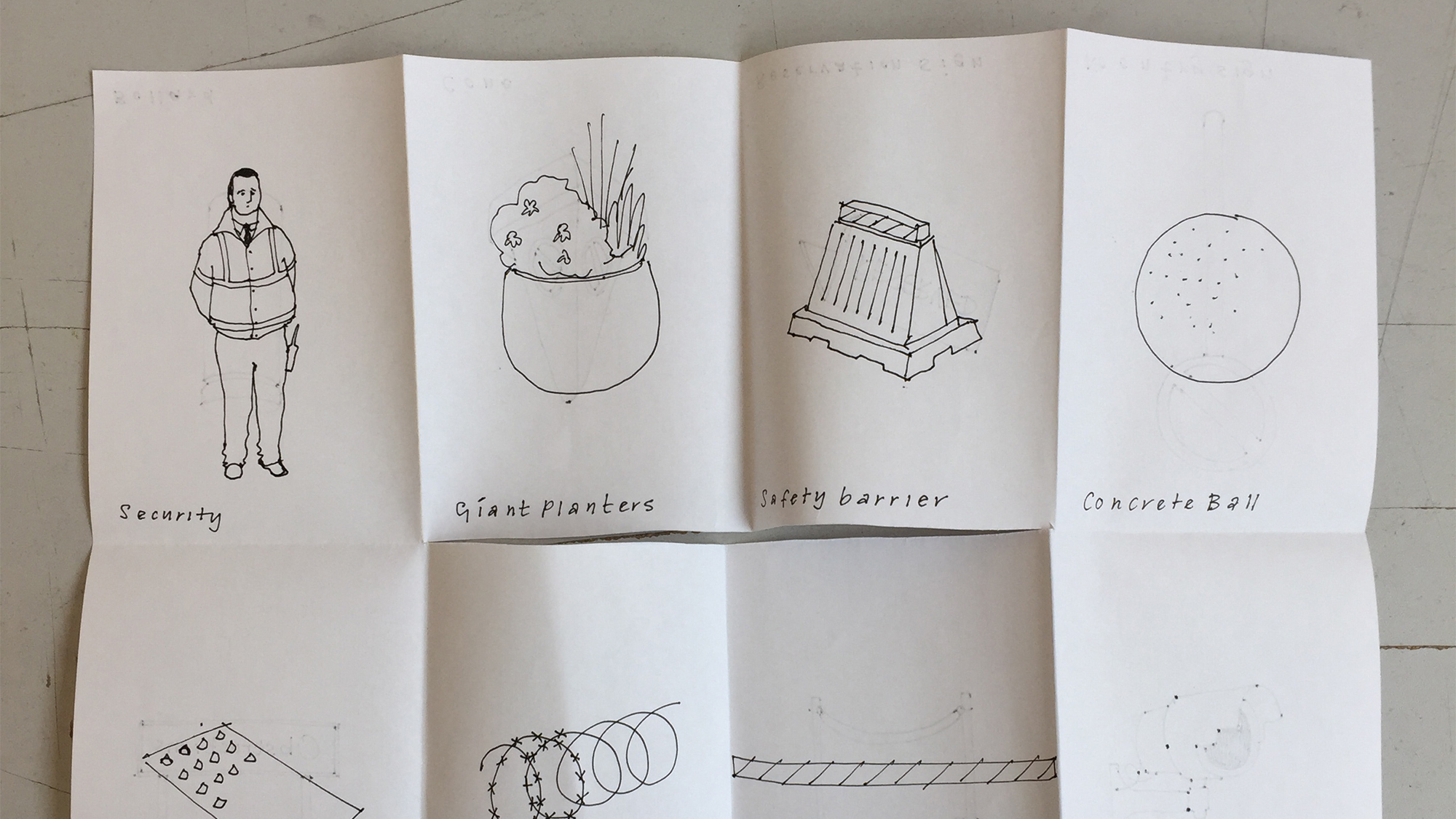



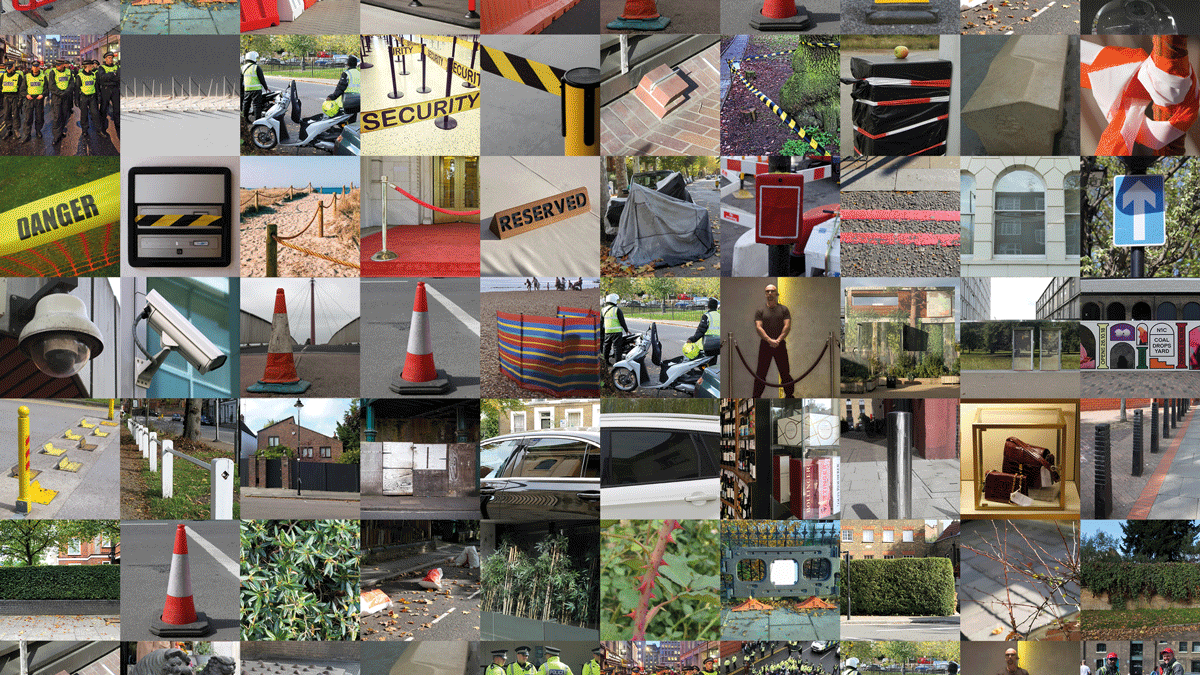

The project developed through workshops, studio experiments, discussion groups and presentations, which I recorded on my Process Blog.
It interrogated what we understand about the term ‘public realm’ and homed in on the presence and visual language of prohibitive objects and people, rather than written signs, in our urban landscape. This culminated in the dissertation publication Obstructions and short film Obstructions of King’s Cross.
It interrogated what we understand about the term ‘public realm’ and homed in on the presence and visual language of prohibitive objects and people, rather than written signs, in our urban landscape. This culminated in the dissertation publication Obstructions and short film Obstructions of King’s Cross.









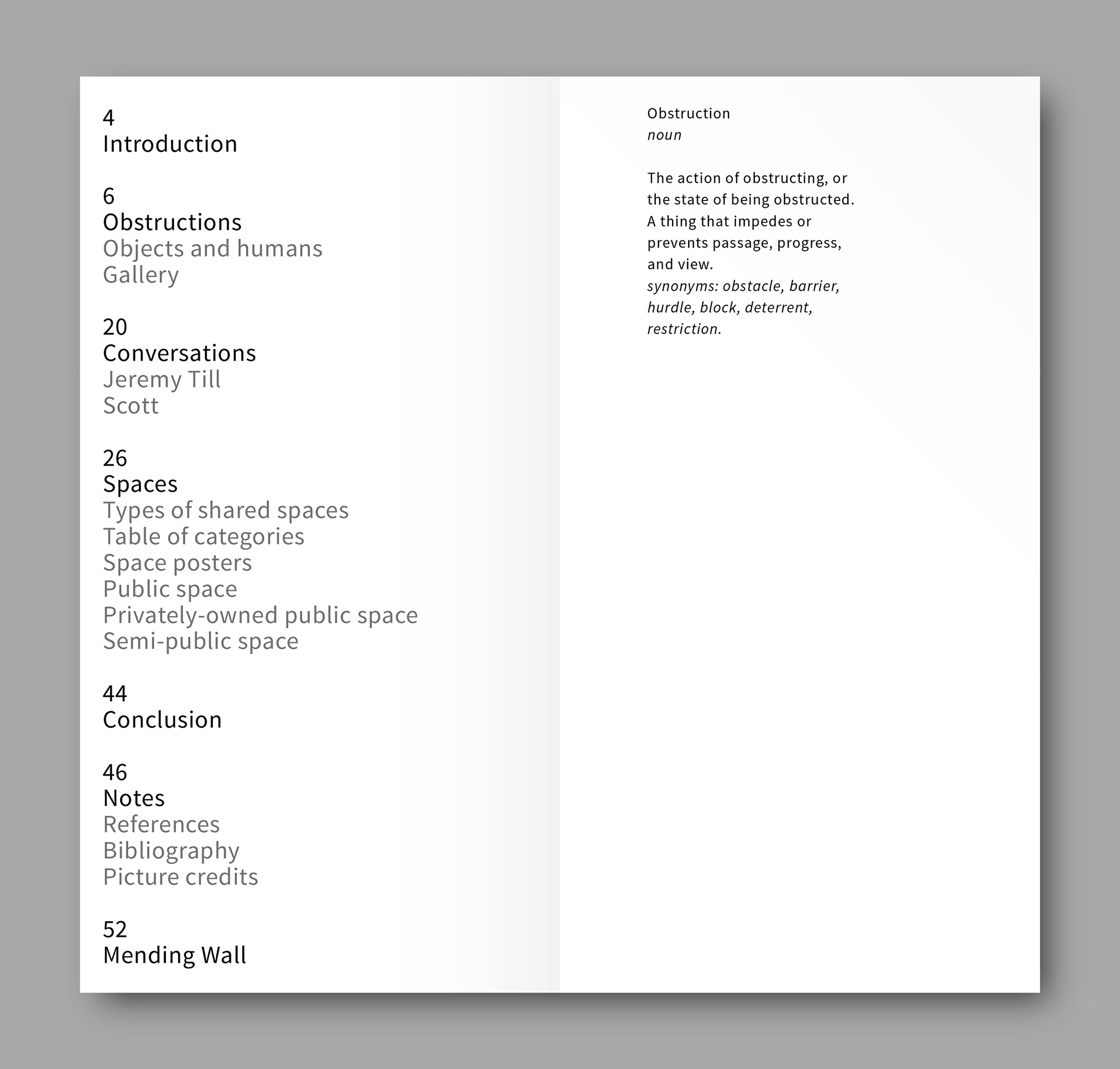





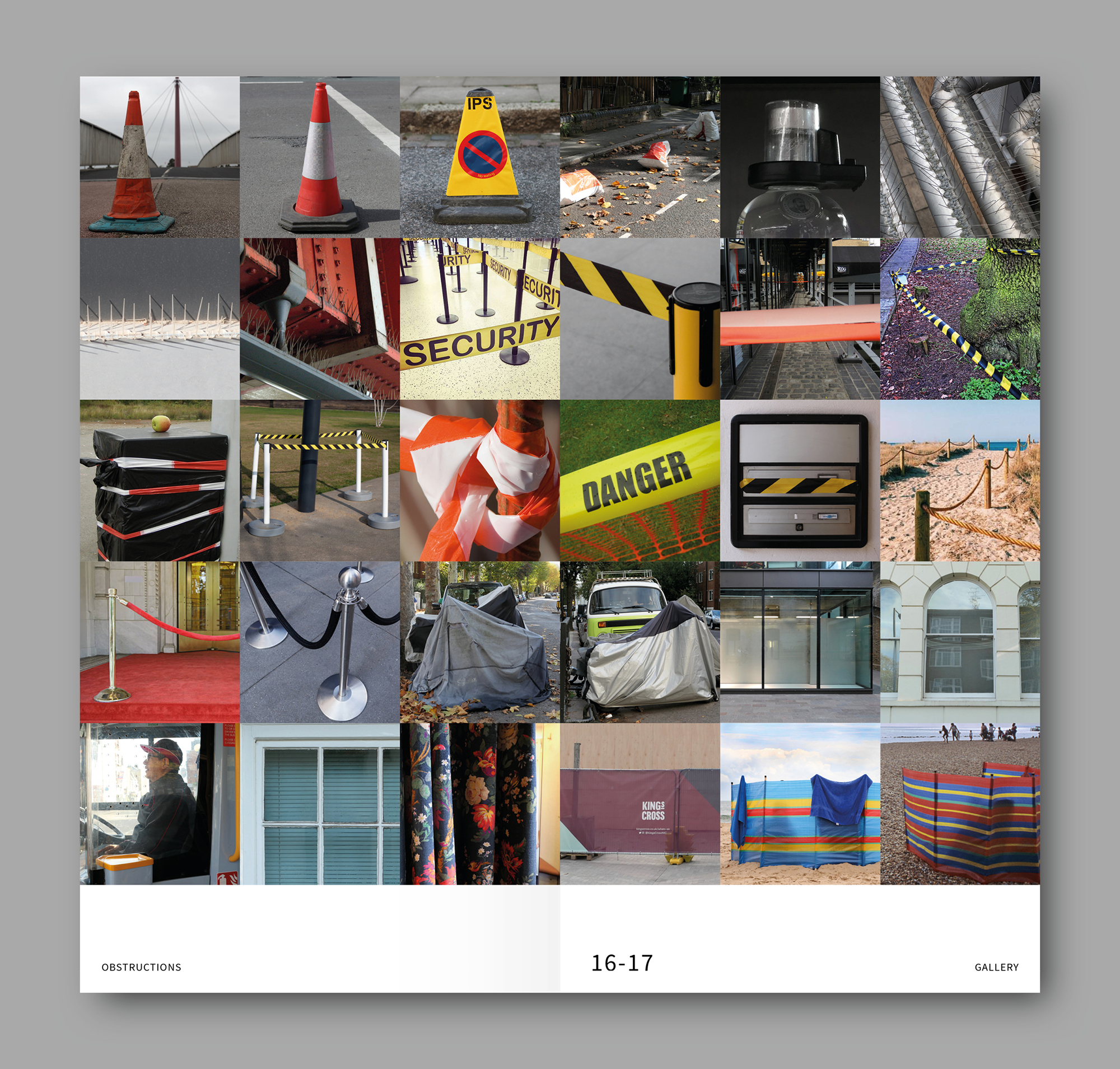


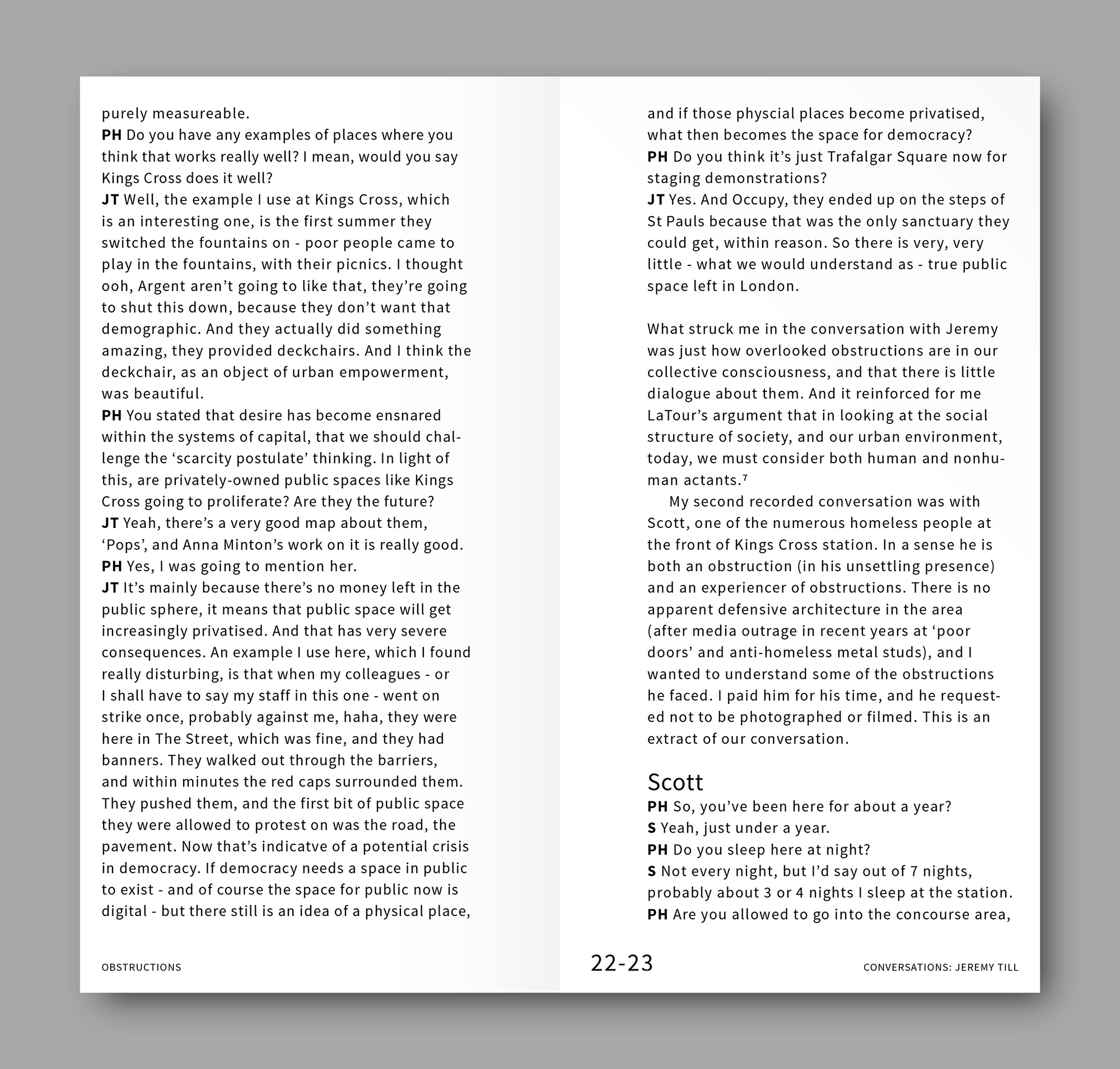
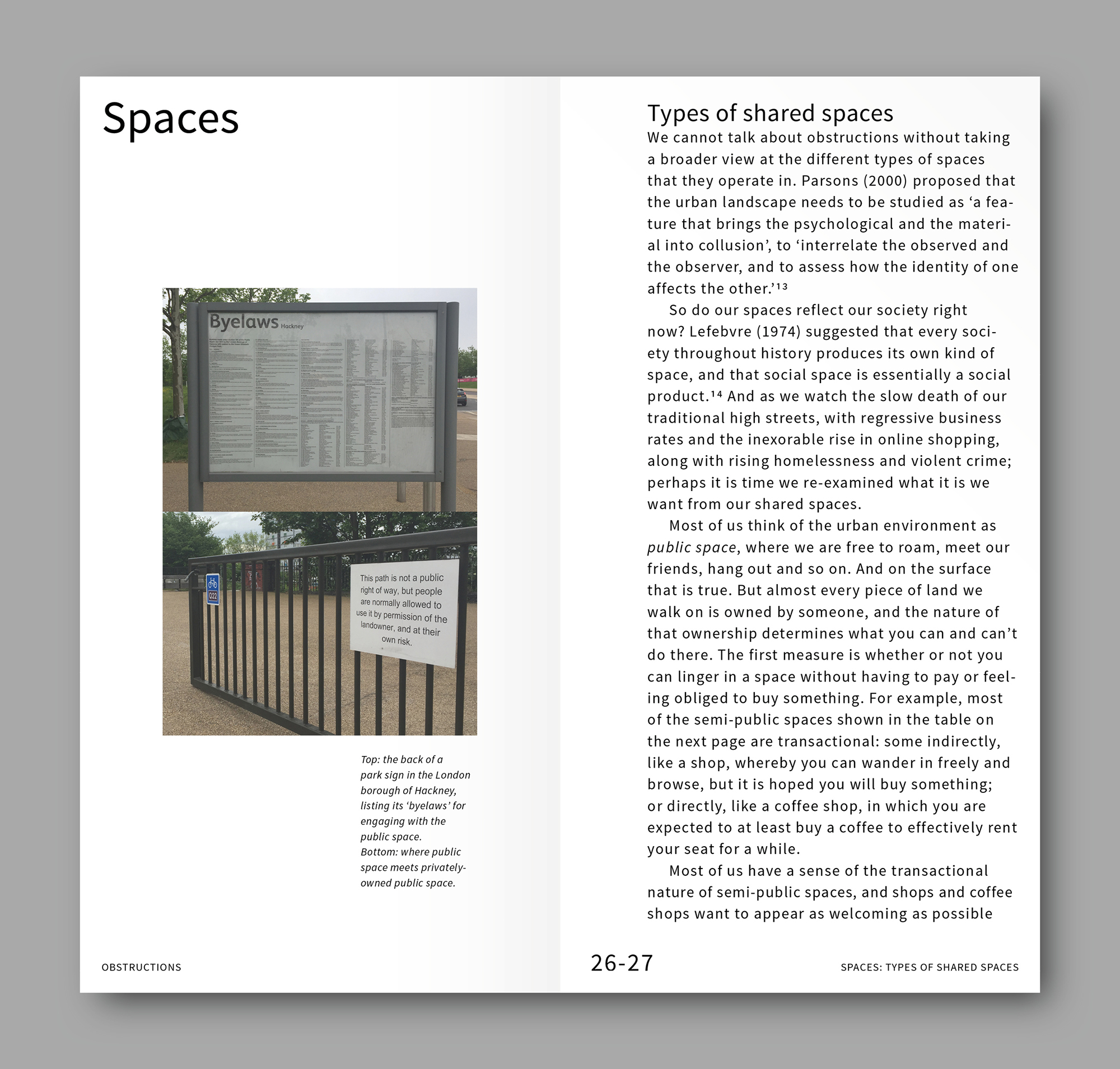
Obstructions proposes that public space can be divided into categories and sub-categories, and it examines the level of ‘transaction’ within each as well as the presence of obstructions.
The gallery pages contain pictures of obstructions informally grouped by their intentions, or ‘prescriptions’ as Bruno Latour described them; as well as their primary material, ie, signs, plastic, tape, wood, glass, planting, stone or human in uniform. The images are placed closely together as a typology, to reveal the normalisation and invisibleness of obstructions, and their scope through variety and ubiquity.
The gallery pages contain pictures of obstructions informally grouped by their intentions, or ‘prescriptions’ as Bruno Latour described them; as well as their primary material, ie, signs, plastic, tape, wood, glass, planting, stone or human in uniform. The images are placed closely together as a typology, to reveal the normalisation and invisibleness of obstructions, and their scope through variety and ubiquity.
Obstructions of King’s Cross concentrates on a London area that has undergone rapid gentrification in recent years. It compares the presence and purpose of obstructions within the area’s three distinct zones: its major transport hubs, privately-owned public spaces, and edges - where signs of its former deprivation can still be seen.
No Ball Games
(2018)Branding
No Ball Games, along with Idle Free Zone and Permit Holders Only were the winning set of beer names and label designs for the Central St Martins’ 2018 competition for its first ever limited edition beer collaboration, with London craft brewer Hammerton. Ready in time to celebrate the first of the college’s two annual degree shows.
The idea came from research I was doing into all the local street signs that tell us NO and DON’T for my MA project Obstructions, and I shortlisted these three. Swapping the context of these normally prohibitive messages from urban streets to beer labels for a creative institute renowned for breaking boundaries offered playful new meanings.
The idea came from research I was doing into all the local street signs that tell us NO and DON’T for my MA project Obstructions, and I shortlisted these three. Swapping the context of these normally prohibitive messages from urban streets to beer labels for a creative institute renowned for breaking boundaries offered playful new meanings.
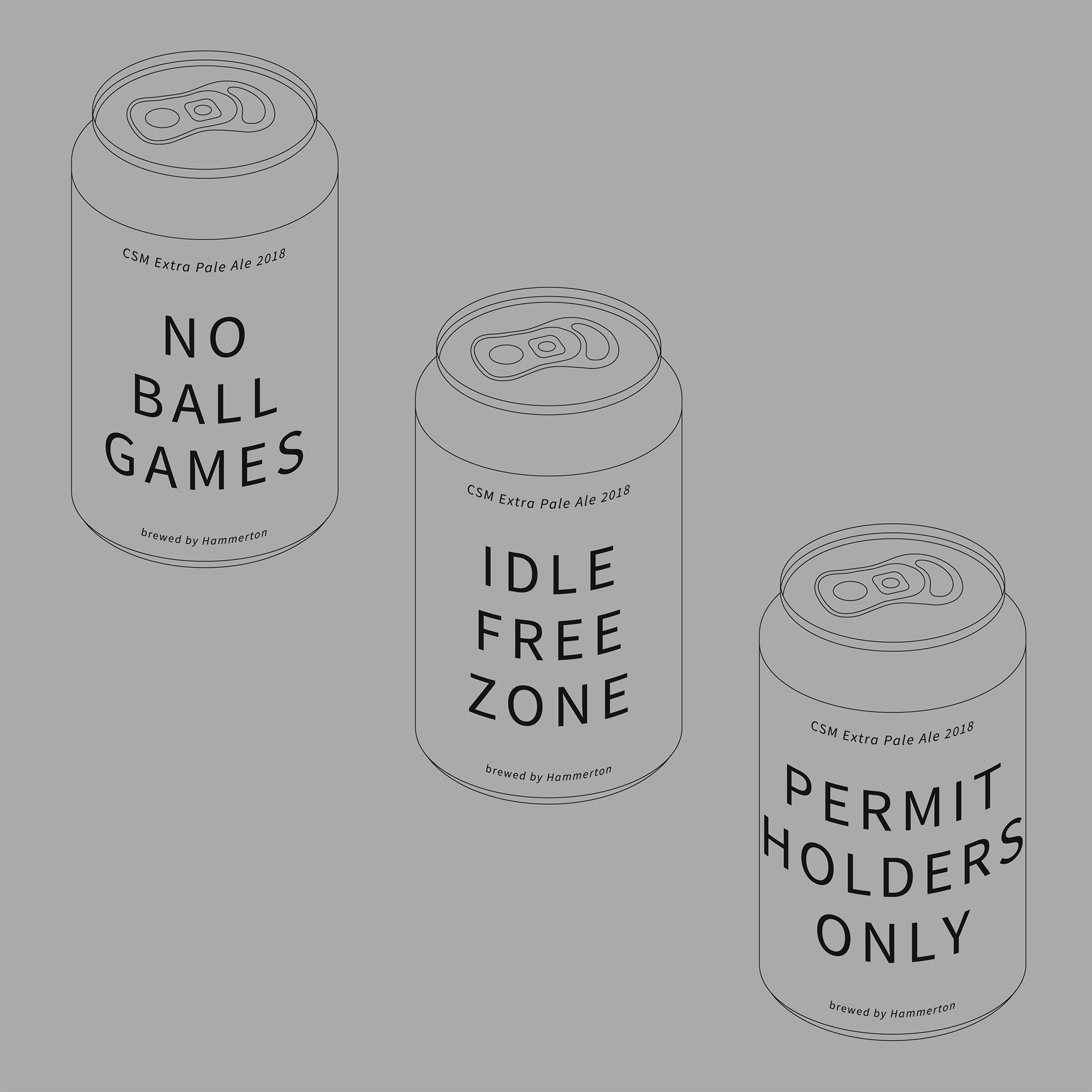
No Ball Games / Noise Nuisance / Idle Free Zone / No Left Turn / Permit Holders Only / Keep Clear / Exit Only / Do Not Climb / No Alcohol / No Stopping / No Pedestrian Access /No Rollerblading Or Skateboarding / No Dumping / Dog Free Area / Bill Stckers Will Be Prosecuted / Controlled Zone / No Ball Games / Noise Nuisance / Idle Free Zone / No Left Turn / Permit Holders Only / Keep Clear / Exit Only / Do Not Climb / No Alcohol / No Stopping / No Pedestrian Access /No Rollerblading Or Skateboarding / No Dumping / Dog Free Area / Bill Stckers Will Be Prosecuted / Controlled Zone / No Ball Games / Noise Nuisance / Idle Free Zone / No Left Turn / Permit Holders Only / Keep Clear / Exit Only / Do Not Climb / No Alcohol / No Stopping / No Pedestrian Access /No Rollerblading Or Skateboarding / No Dumping / Dog Free Area / Bill Stckers Will Be Prosecuted / Controlled Zone / No Ball Games / Noise Nuisance / Idle Free Zone / No Left Turn / Permit Holders Only / Keep Clear / Exit Only / Do Not Climb / No Alcohol / No Stopping / No Pedestrian Access /No Rollerblading Or Skateboarding / No Dumping / Dog Free Area / Bill Stckers Will Be Prosecuted / Controlled Zone /

Global Art Project (GAP)
(2018)Study tour/residency
Publication, A2 (folded to A4)
Exhibition poster, A3
Book/essay, A5, 16pp
Film, 5:20 mins, 16:9
Organised by Central St Martins and Tokyo University of the Arts, this programme spanned London, Tokyo and Hong Kong. Our small group explored themes around history and identity through visits, trips, screenings and talks; as well as collaborating in workshops and public exhibitions in each location.

Workshops in London and Tokyo, and pop-up public event in Hong Kong.
The programme culminated for me in this printed poster/essay #Seeds, which draws on parallels between native tree seeds and trending social media hashtags as ‘ingredients’ of the natural and social landscapes of both the UK and Japan.
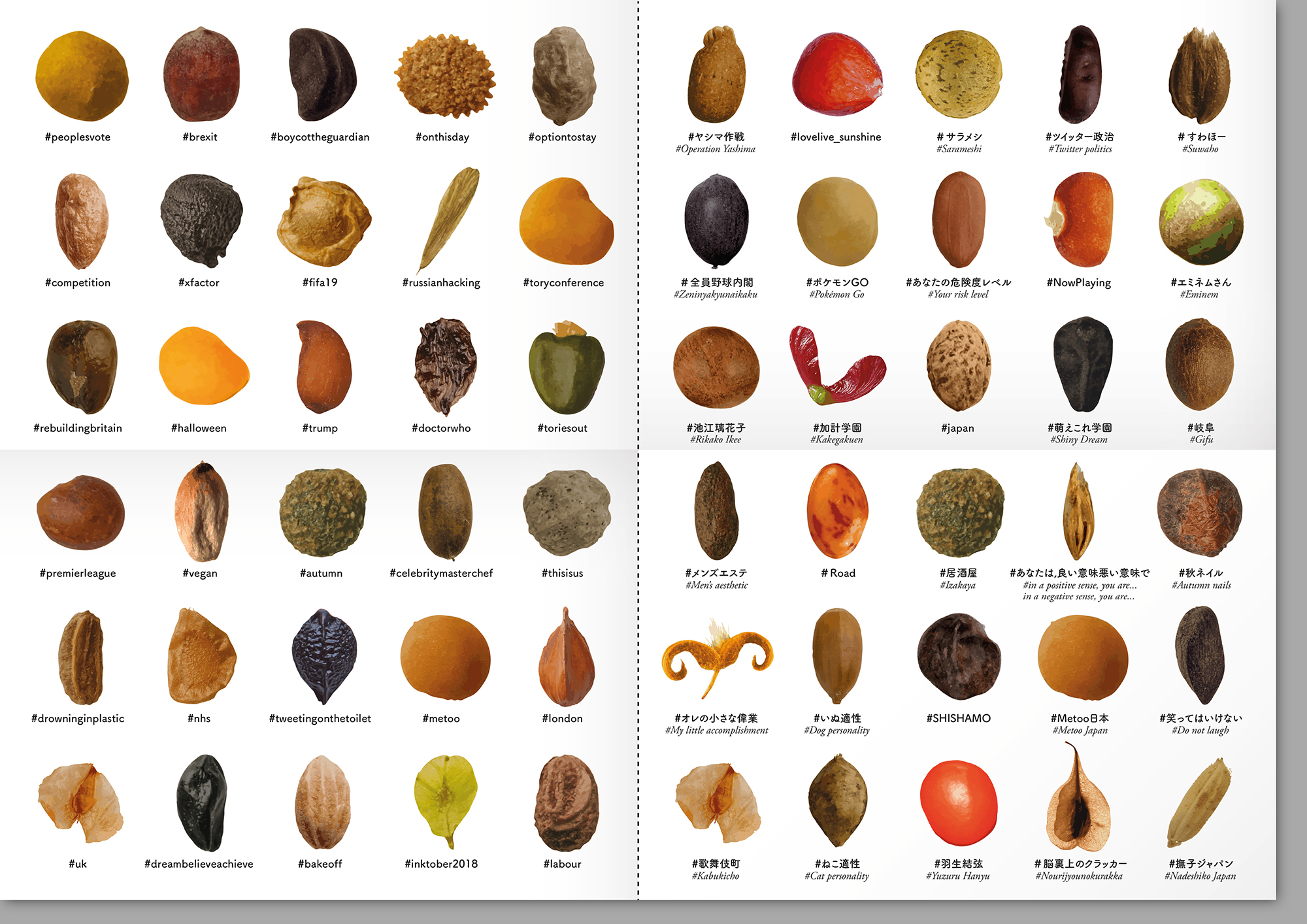
 #Seeds, the A2 printed publication, folded to A4.
#Seeds, the A2 printed publication, folded to A4.The first of our three public exhibitions took place in Hong Kong, on the final leg of the trip. We gathered together material and put on Re:mind the GAP in our gallery space at Hart Haus. This was my poster for it.

My film 3 Moments was screened in the show, using footage I had shot along the way. The film reflects on the tension between cultural remembrance and that which gets forgotten or overlooked.
The film is in three parts, each one filmed in a Sunday in the three different locations.
Shrine, studies visitors’ contemplation and remembrance at the Ueno Tōshō-gū shrine in Tokyo, with the unexpected presence of Dvorak’s Symphony No.9 playing on outdoor speakers.
Field gazes out across a grassy field in Dorset and reflects on the rise of extremism in the modern world to an extract from Charlie Chaplin’s 1930s speech from The Great Dictator.
Maids observes hoards of low-paid domestic workers in central Hong Kong on their Sunday off. In makeshift cardboard villages outside the luxury brands, they hang out with friends, video-call their families and trade goods.
The film was shot on the go and I cut it quickly together in my Hong Kong hotel room the night before the event, so please forgive its roughness!
Shrine, studies visitors’ contemplation and remembrance at the Ueno Tōshō-gū shrine in Tokyo, with the unexpected presence of Dvorak’s Symphony No.9 playing on outdoor speakers.
Field gazes out across a grassy field in Dorset and reflects on the rise of extremism in the modern world to an extract from Charlie Chaplin’s 1930s speech from The Great Dictator.
Maids observes hoards of low-paid domestic workers in central Hong Kong on their Sunday off. In makeshift cardboard villages outside the luxury brands, they hang out with friends, video-call their families and trade goods.
The film was shot on the go and I cut it quickly together in my Hong Kong hotel room the night before the event, so please forgive its roughness!
The film can be viewed here︎︎︎

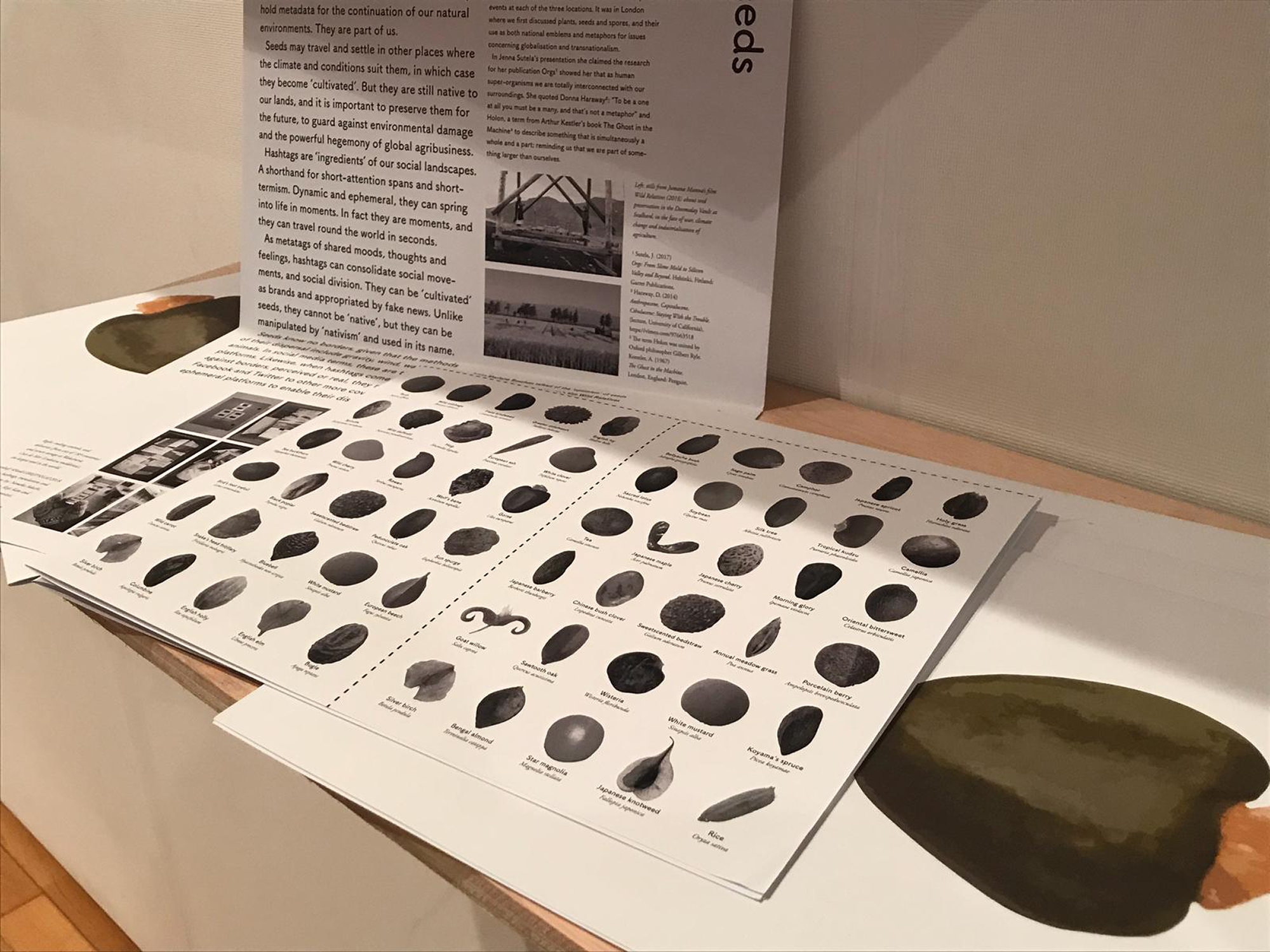
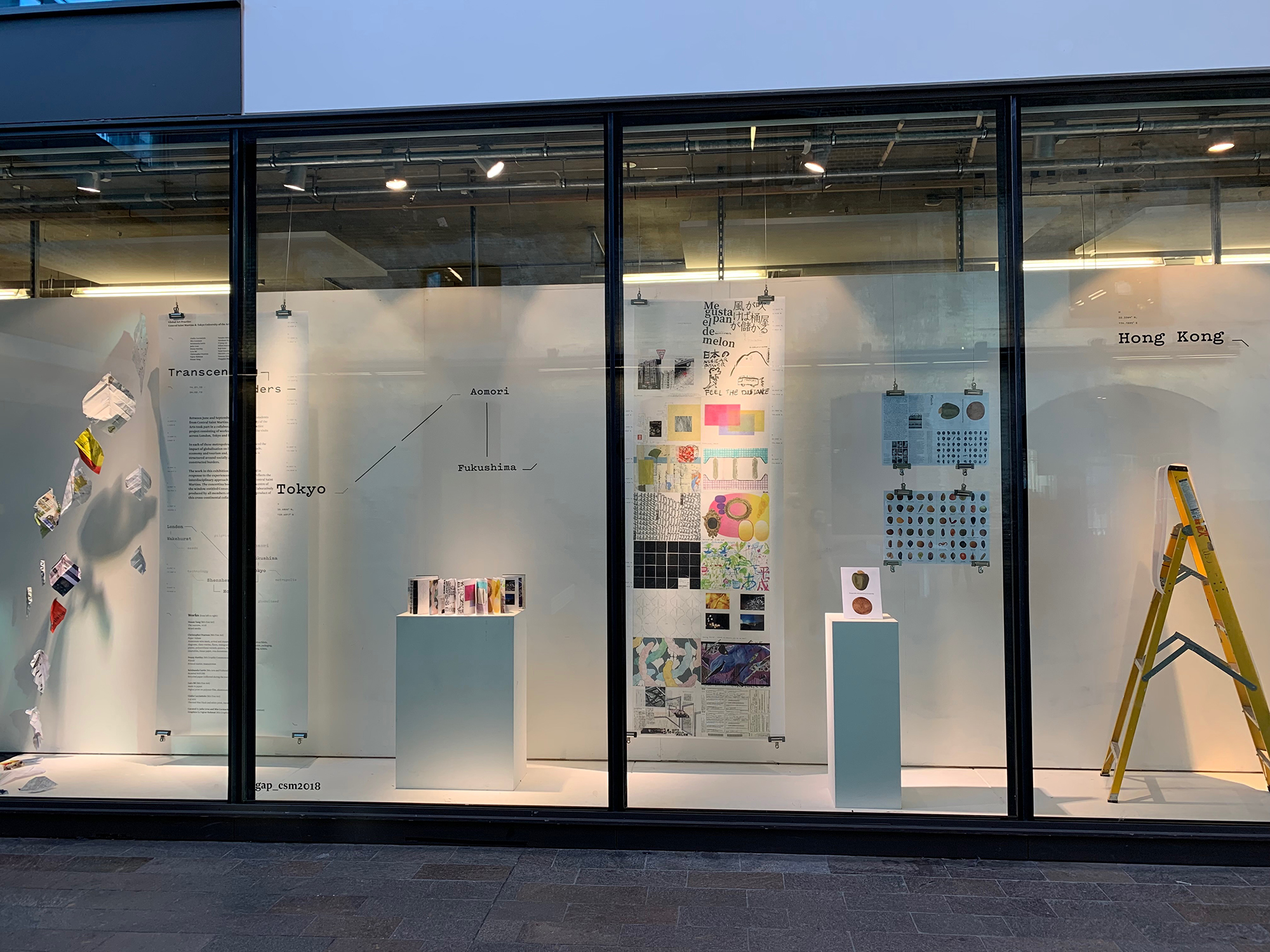
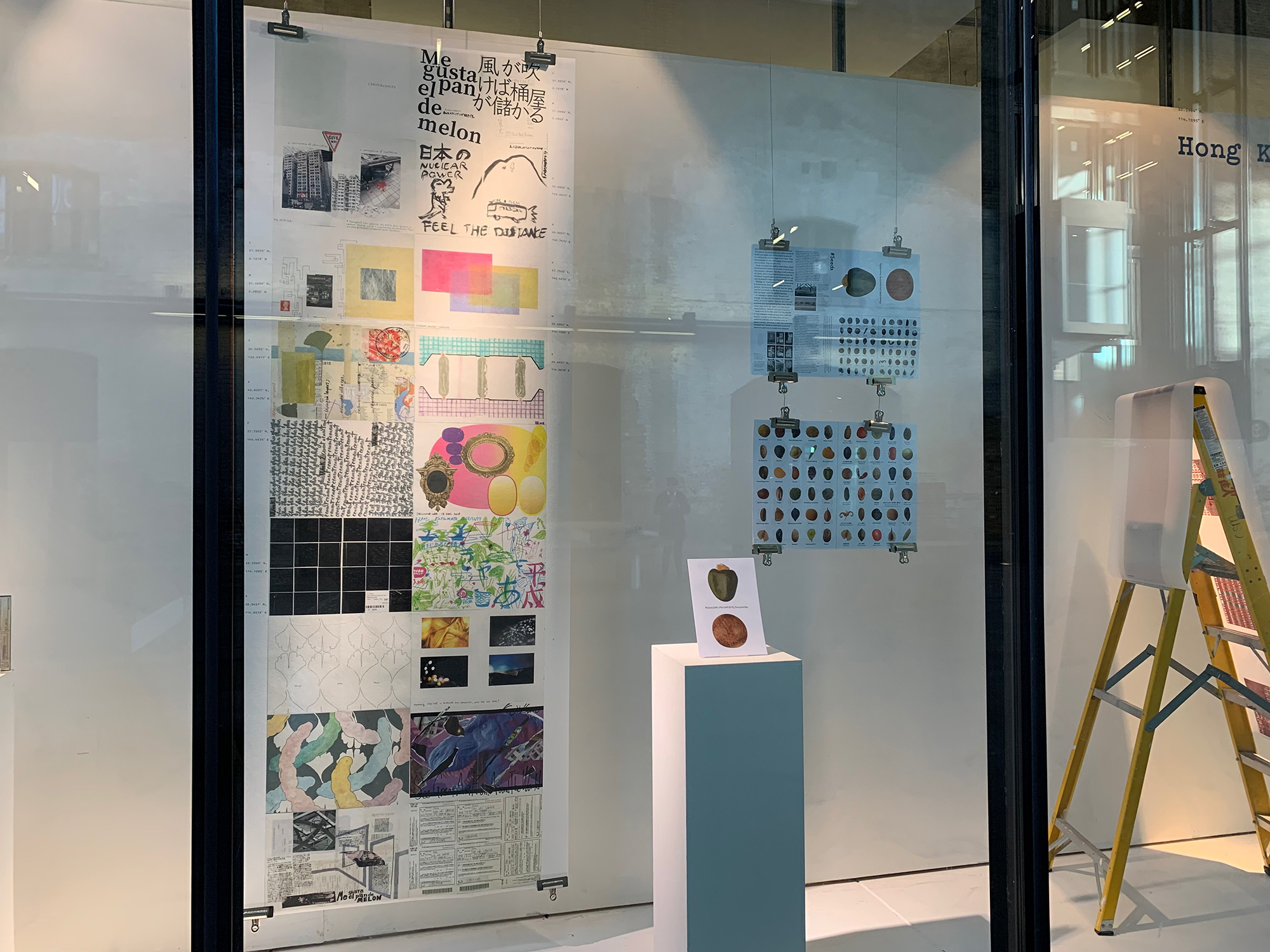
After Hong Kong, our work was subsequently exhibited in group shows at Embracing Borders at the Chinretsukan Gallery, Tokyo, and Transcending Borders at Central St Martins, London.

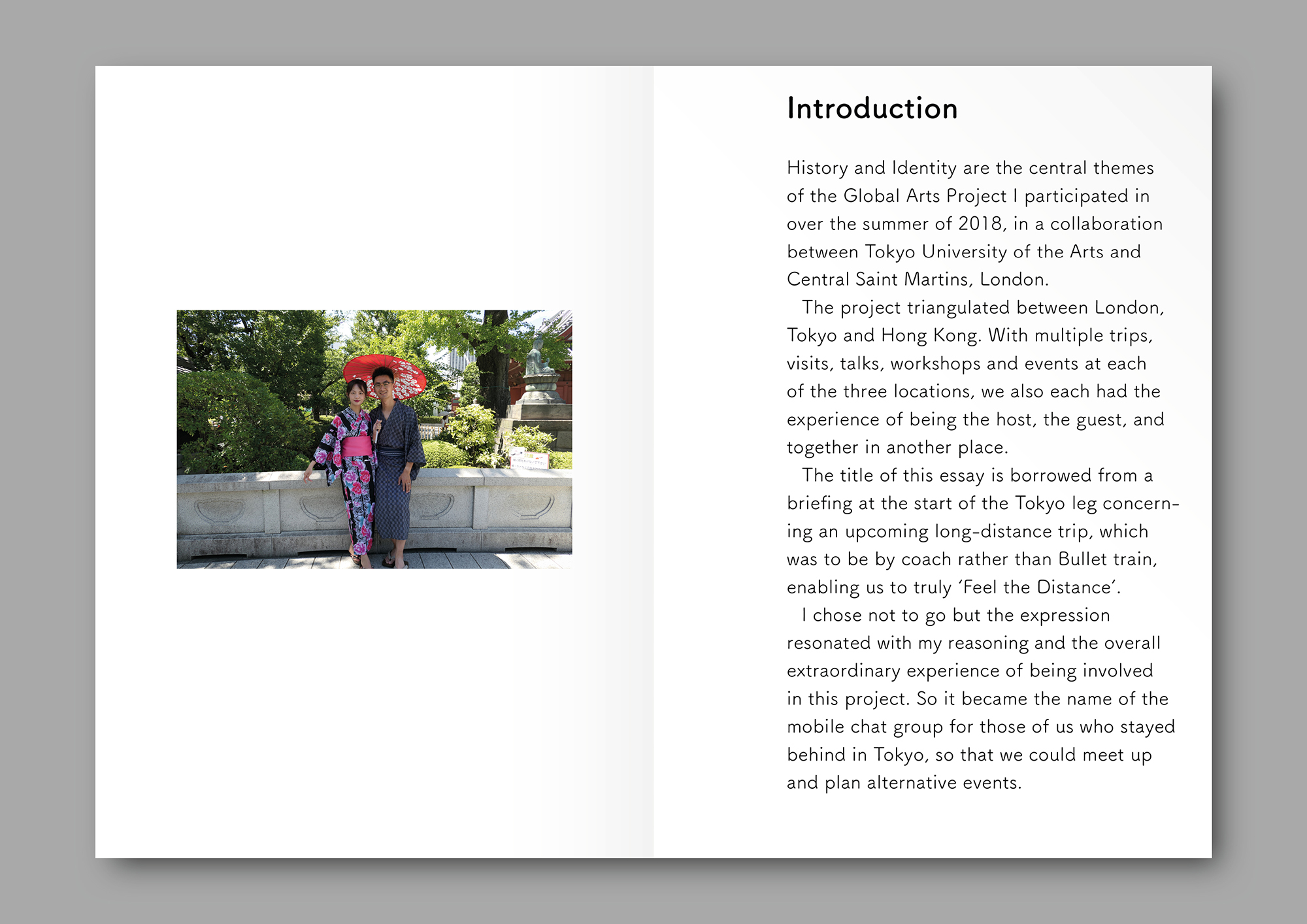


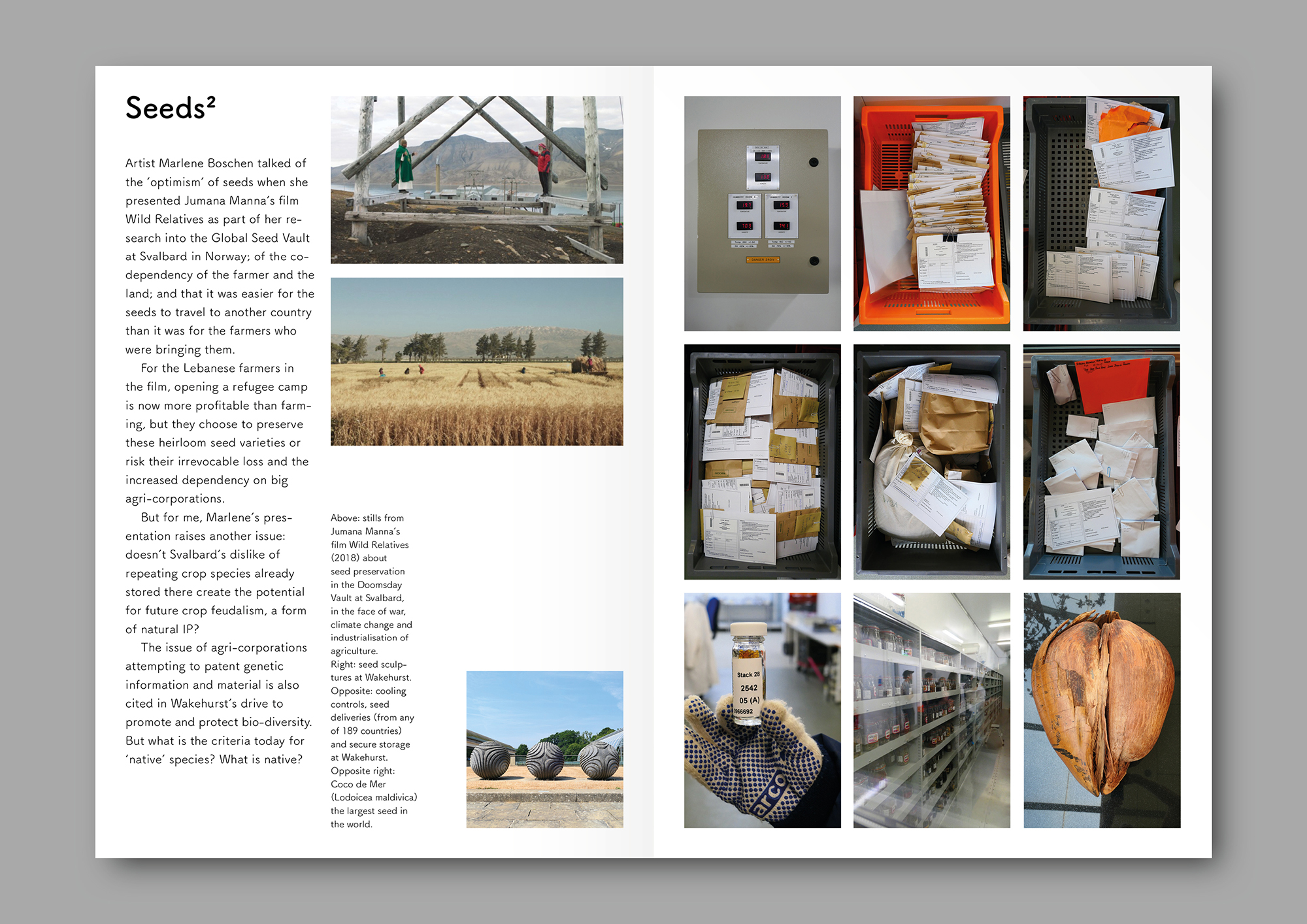
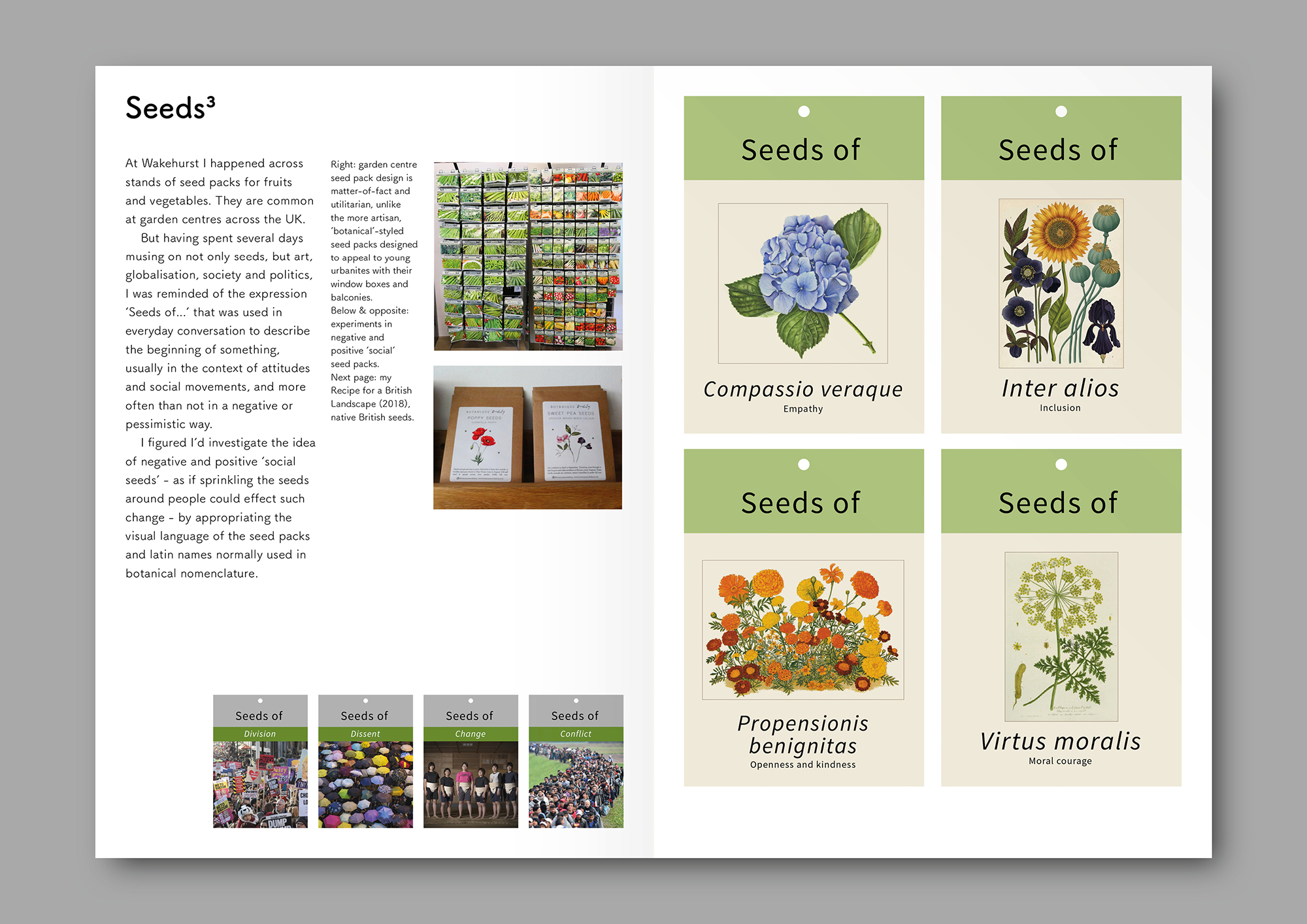
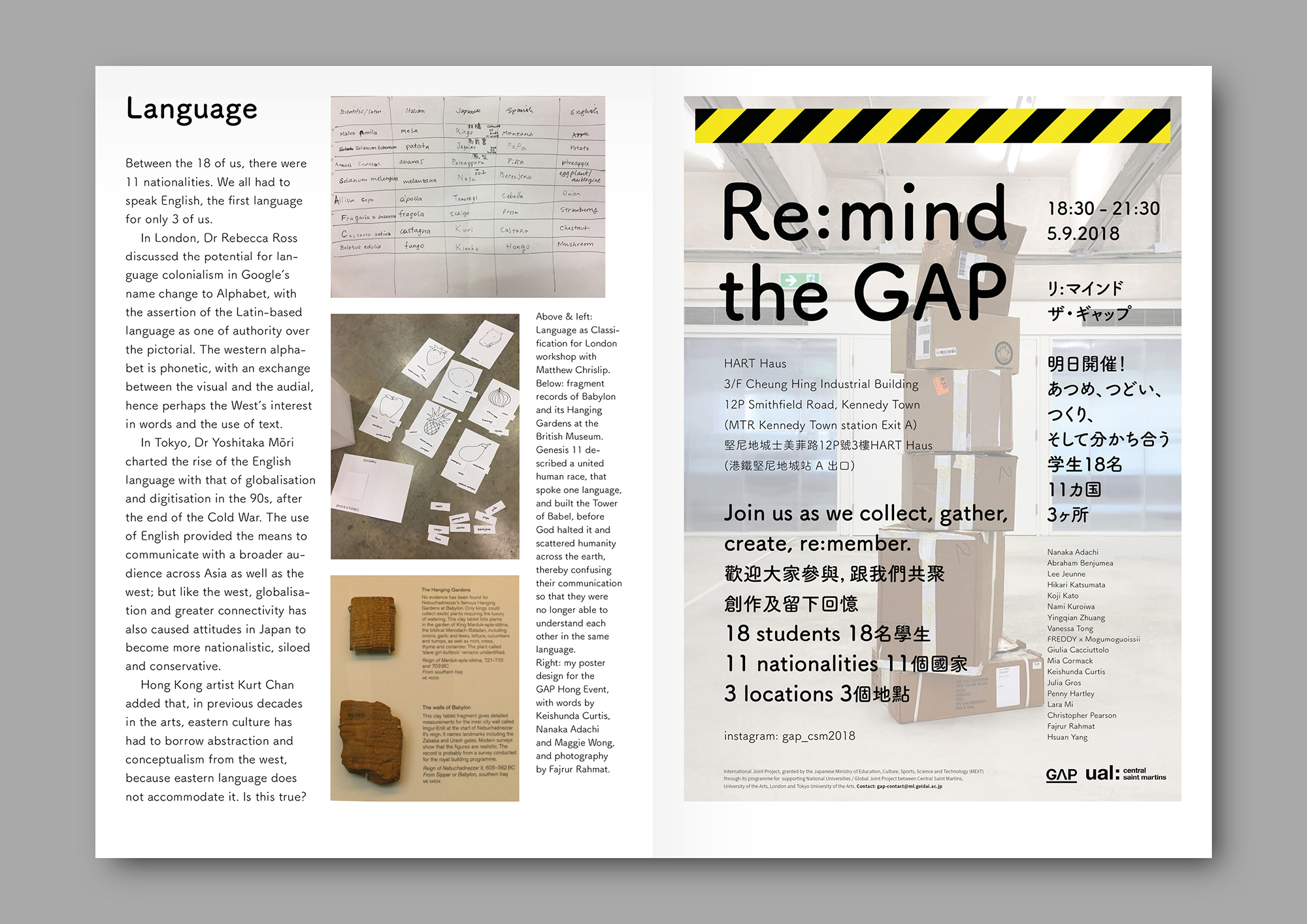

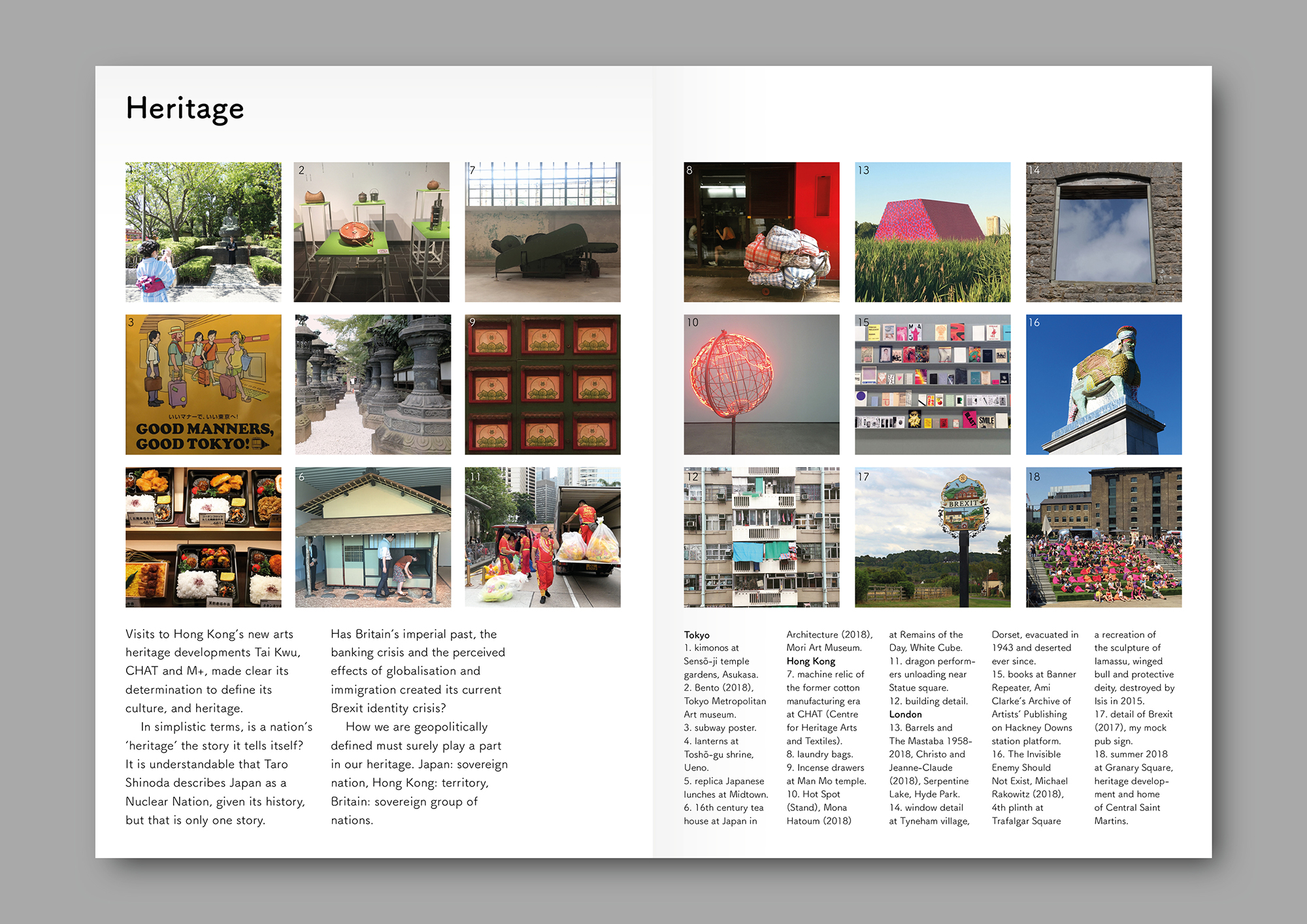
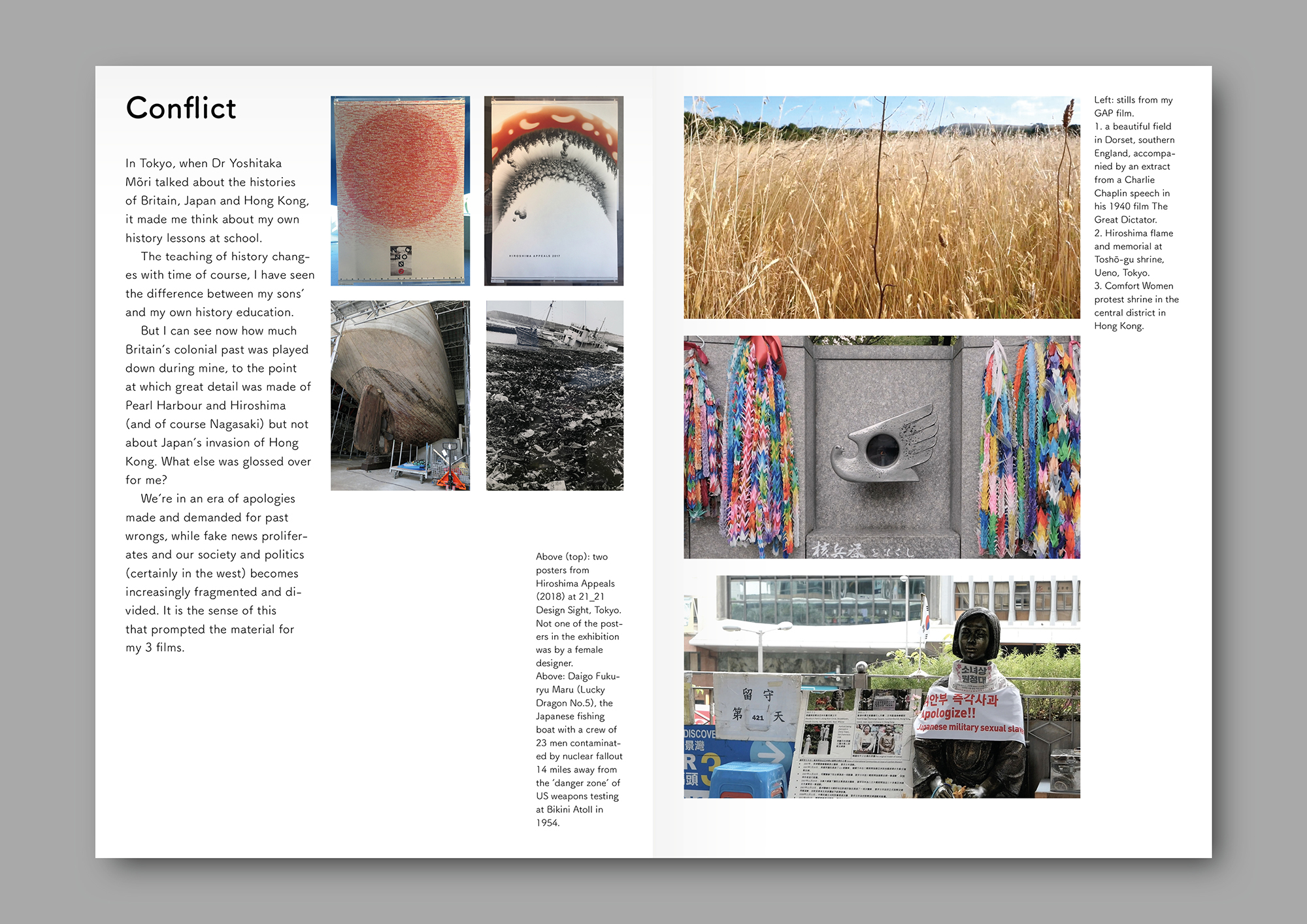
On my return I gathered all the experiences, thoughts and inspirations from the study tour/residency and tried to distill them down into this reflective essay book Feel the Distance, and generating the material for the #Seeds publication.
Picture/translation credits:
#Seeds publication Japanese hashtags, translations and cultural interpretations with the kind help of GAP friends. Re:mind the GAP poster photography by Fajrur Rahmat; Japanese & Cantonese translations by the GAP team. Screening of 3 Moments film photography ©Global Art Joint Curriculum 2018 CSM (UAL) and TUA. Gallery and window exhibition photography by Giulia Cacciuttolo, Nanaka Adachi and Penny Hartley.
#Seeds publication Japanese hashtags, translations and cultural interpretations with the kind help of GAP friends. Re:mind the GAP poster photography by Fajrur Rahmat; Japanese & Cantonese translations by the GAP team. Screening of 3 Moments film photography ©Global Art Joint Curriculum 2018 CSM (UAL) and TUA. Gallery and window exhibition photography by Giulia Cacciuttolo, Nanaka Adachi and Penny Hartley.